How to Use a Live Chat
With the help of "Chats," you have access to chats from your chatbots directly from your SendPulse account — in the browser version or through the application on your smartphone. Here, you can reply to messages from subscribers from all of the chatbots you have connected.
How to Open Chats with Subscribers
The "Conversations" tab
In the "Chatbot" section, go to the "Conversation" tab. Afterward, you will see the page with your chats with subscribers.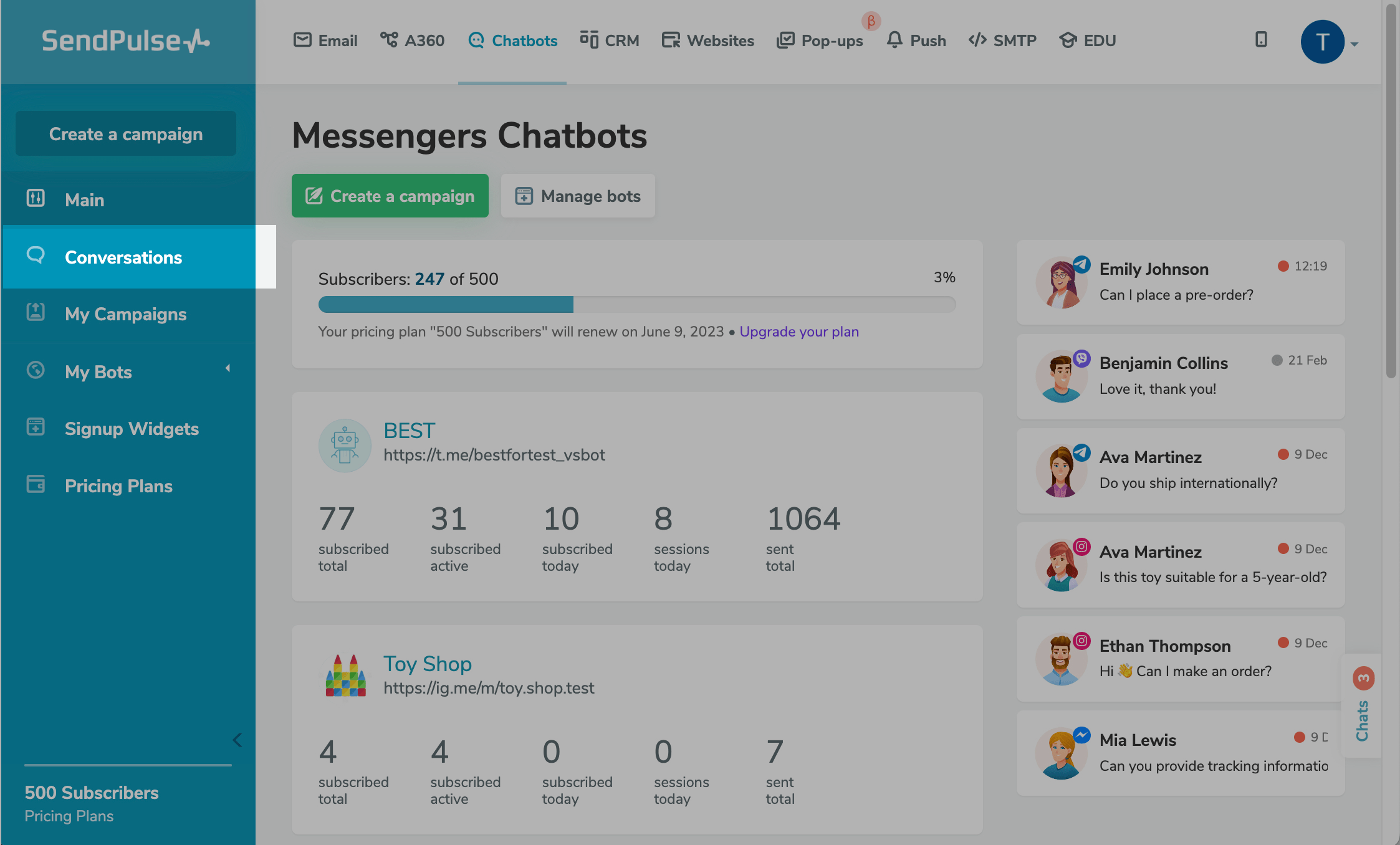
View Recent Messages
On the main page, you can view your recent chat messages. Click a message to open the page with chats.
New messages are marked with a red dot, and closed chats are marked with a gray dot.
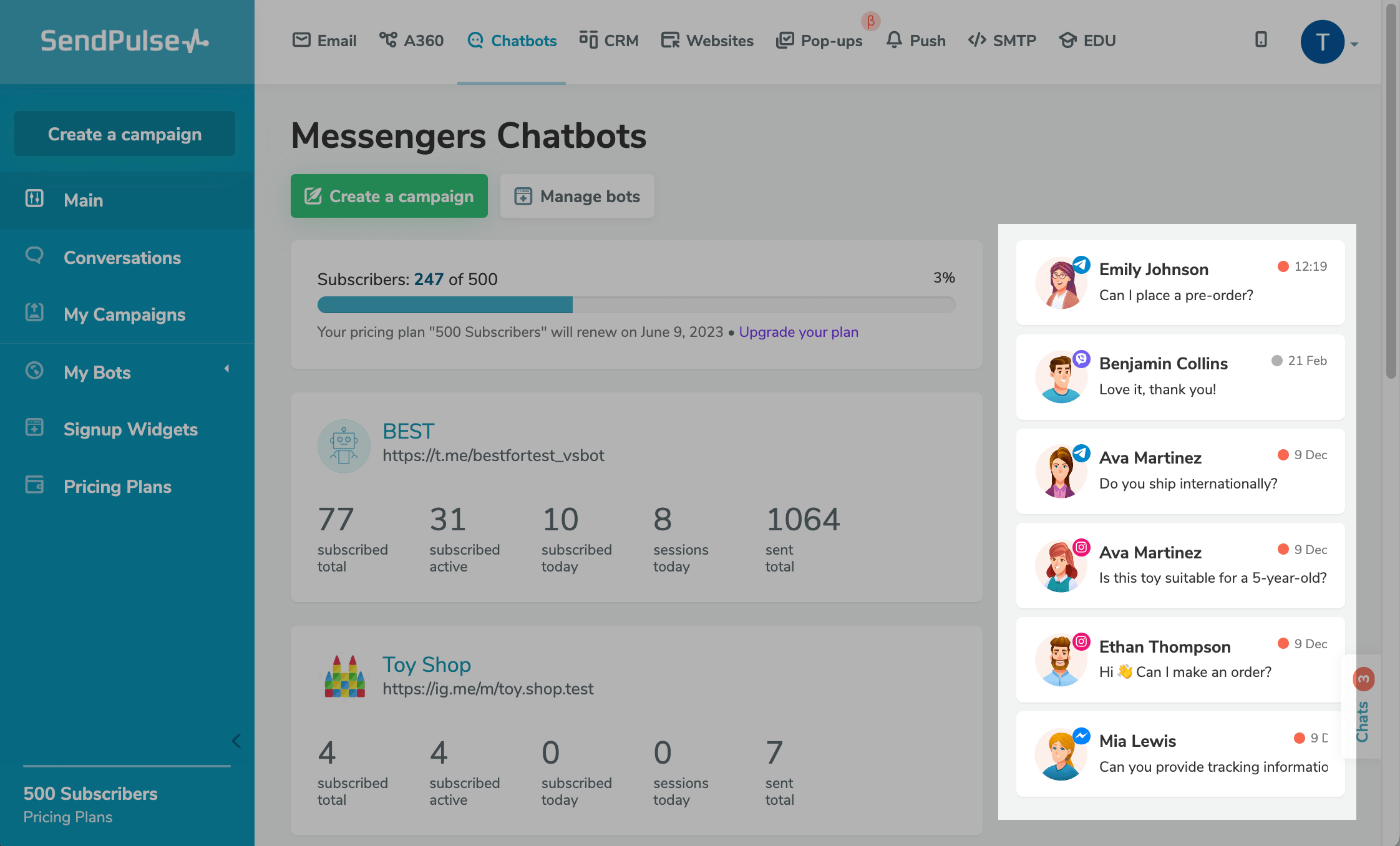
The "Chats" Button
You can access the "Chats" button in all sections of your SendPulse account. This way, you can reply to your bot subscribers even from your CRM system.
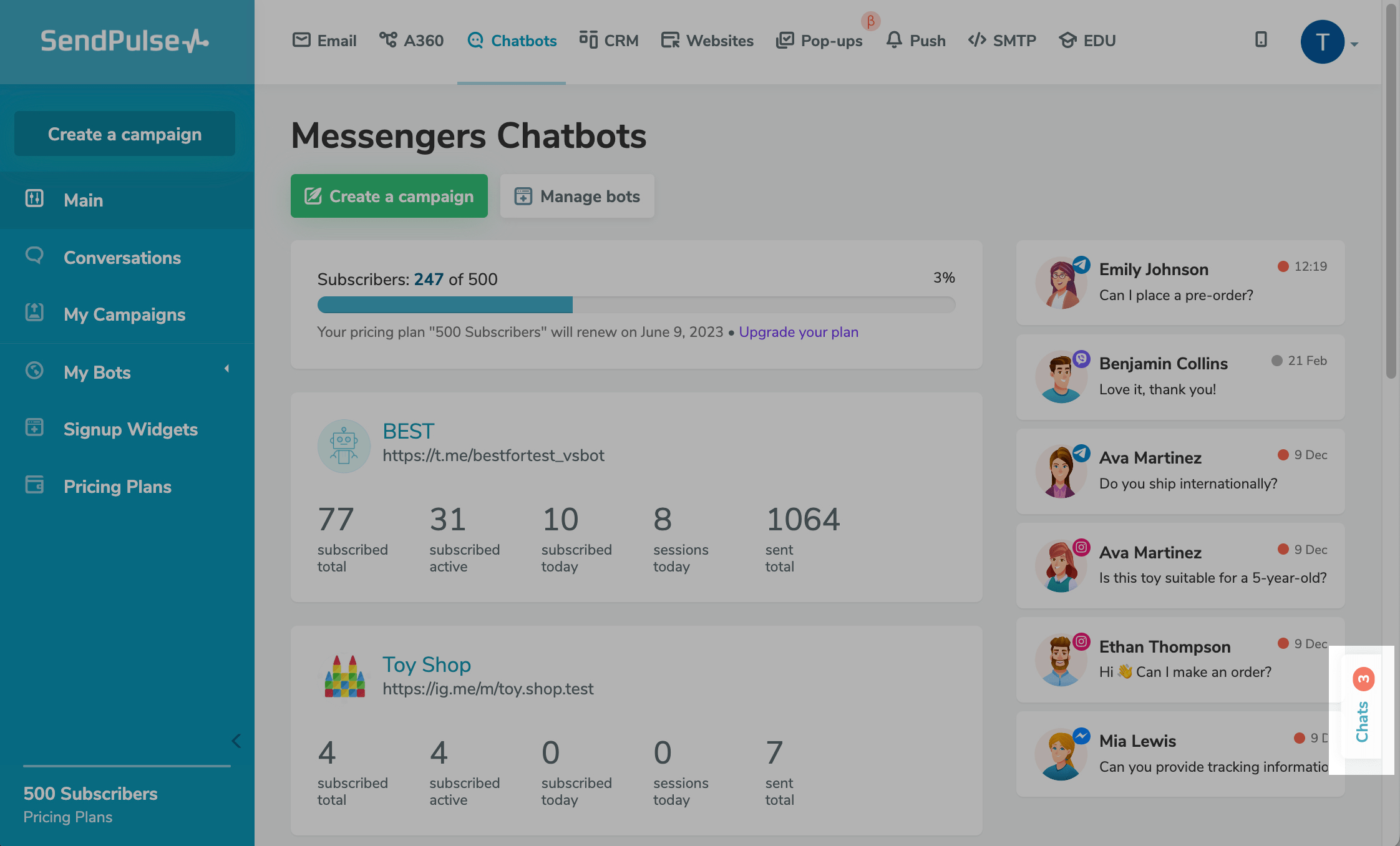
If you have unread messages, the button will display the number of chats with new messages from subscribers.
View Chats
Chats from different bots are divided by tabs. You can see messaging app icons on each bot tab. To view bot chats from a specific messaging app, open a tab with the corresponding icon.
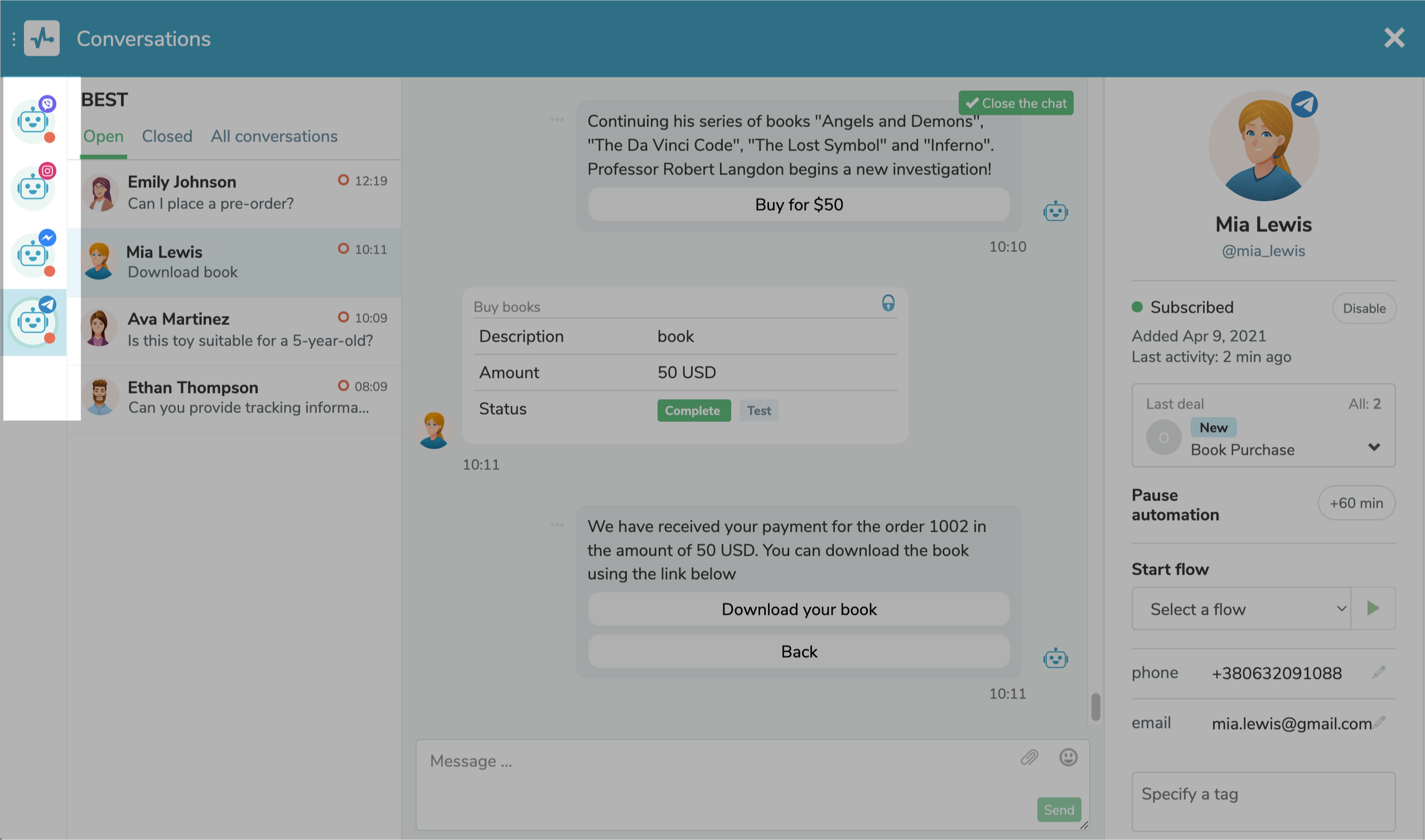
Chat Type
Bot chats are displayed in three tabs — open, closed, and all conversations — with all your open and closed chats gathered in the last one.
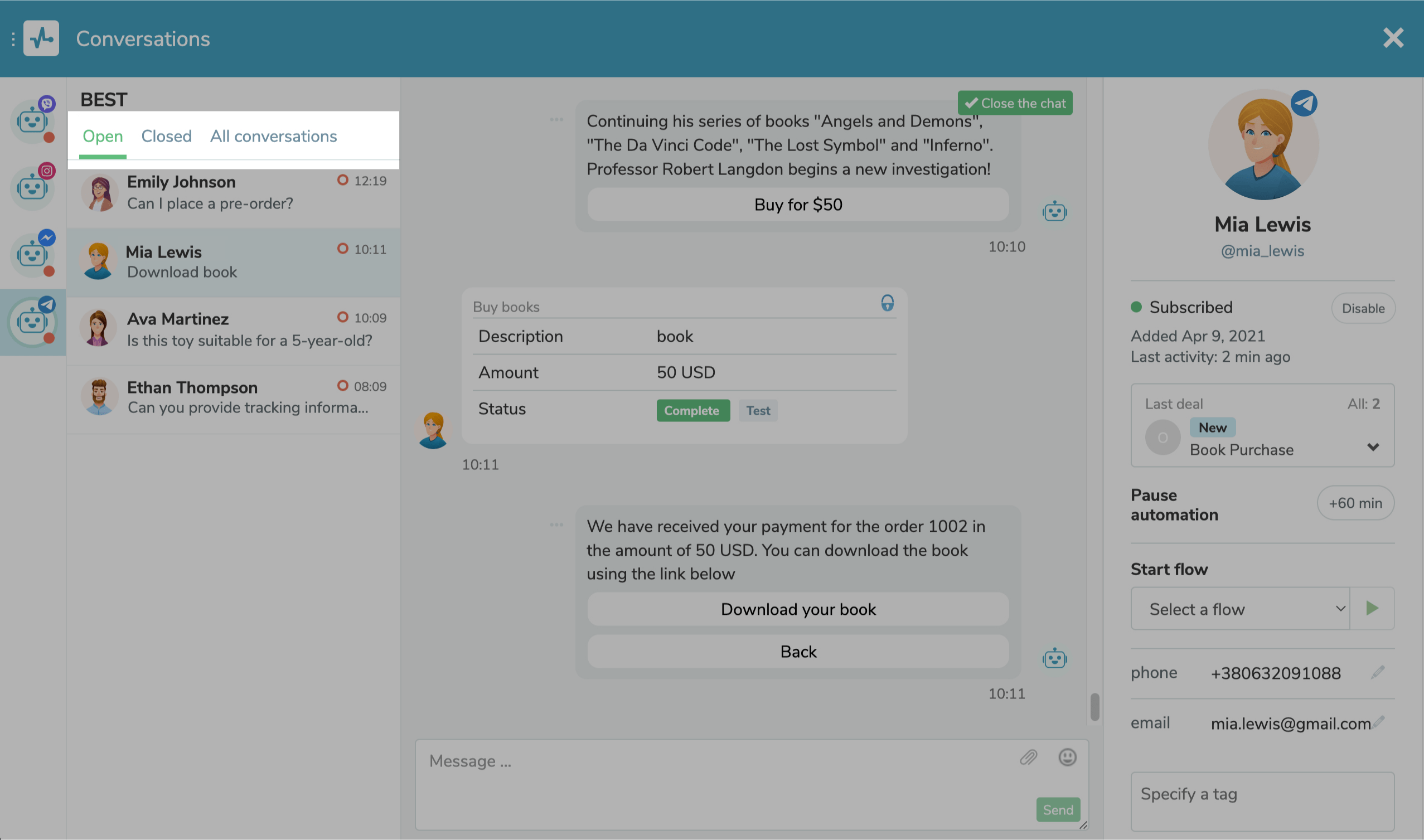
| Open | This tab displays the list of chats with unfinished subscriber conversations. Chats open when a subscriber launches the "Standard reply" flow, reaches the "Action" element, or when you open a chat manually. |
| Closed | This tab displays the list of manually closed chats. |
To close a chat, go to the chat, and click Close the chat.
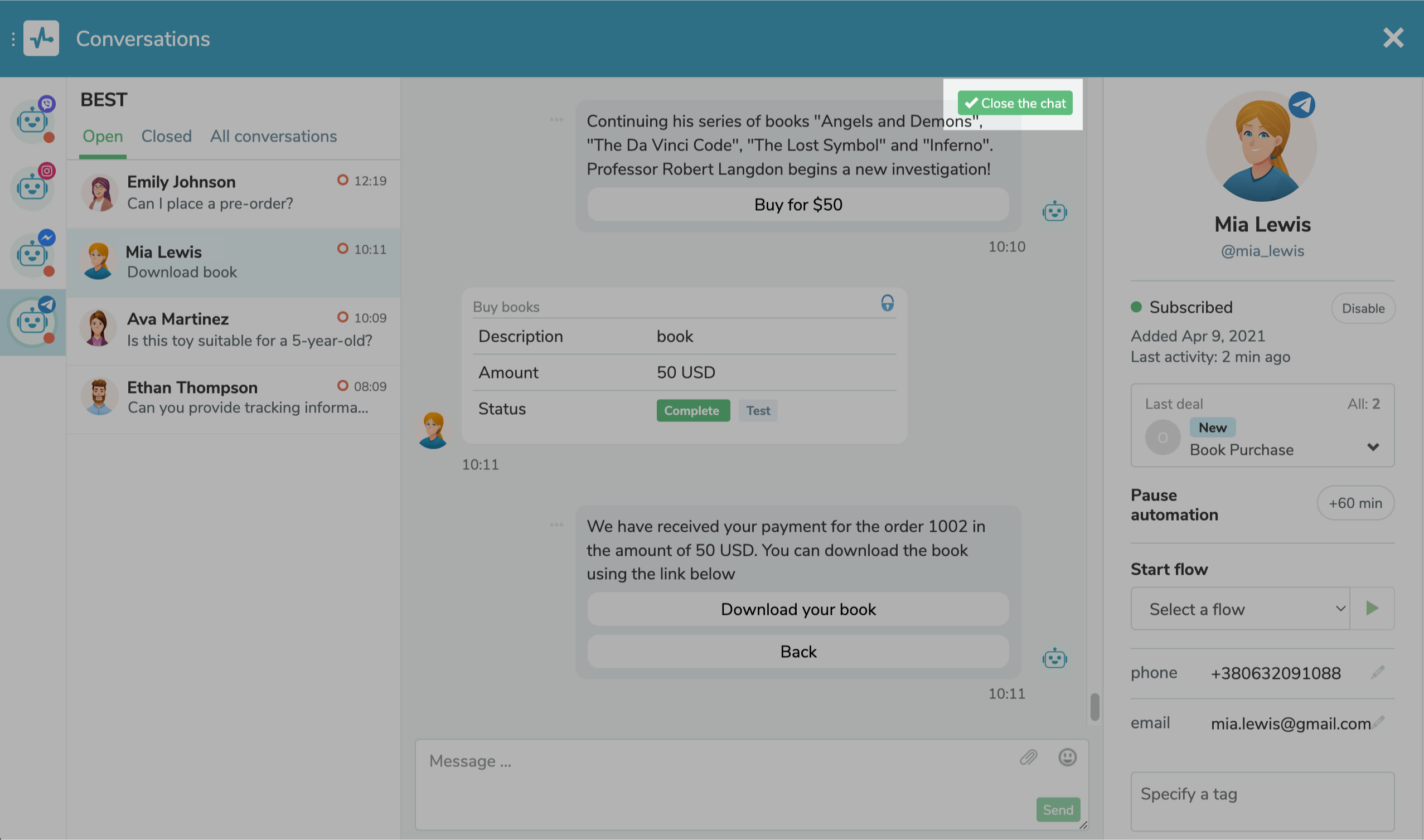
Subscriber Search
You can also find a subscriber using search. Go to the "All conversations" tab, type in a subscriber name, and select a chat from the list.
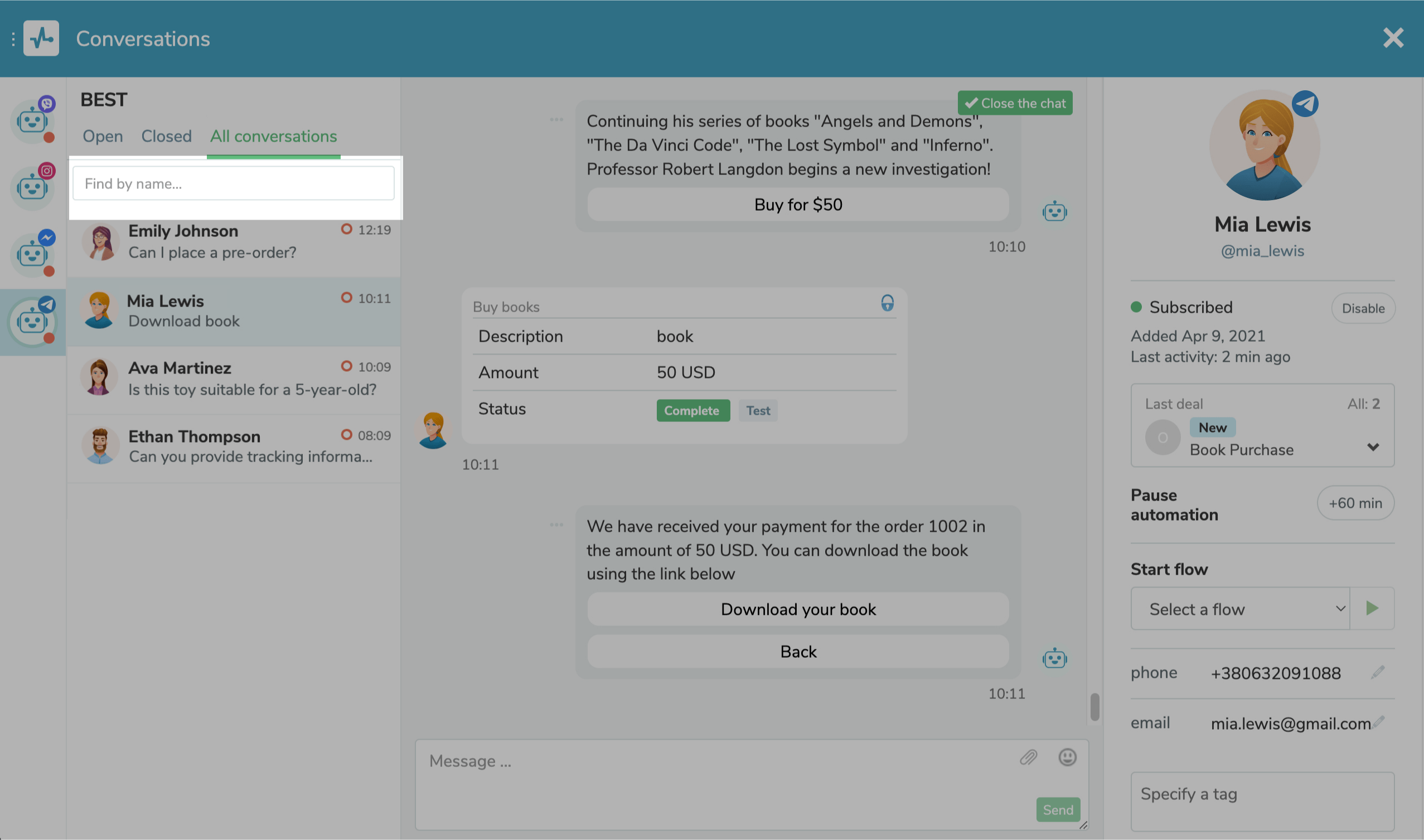
Message History
In each chat window, you can view the whole history of conversations with subscribers, including your bot's replies.
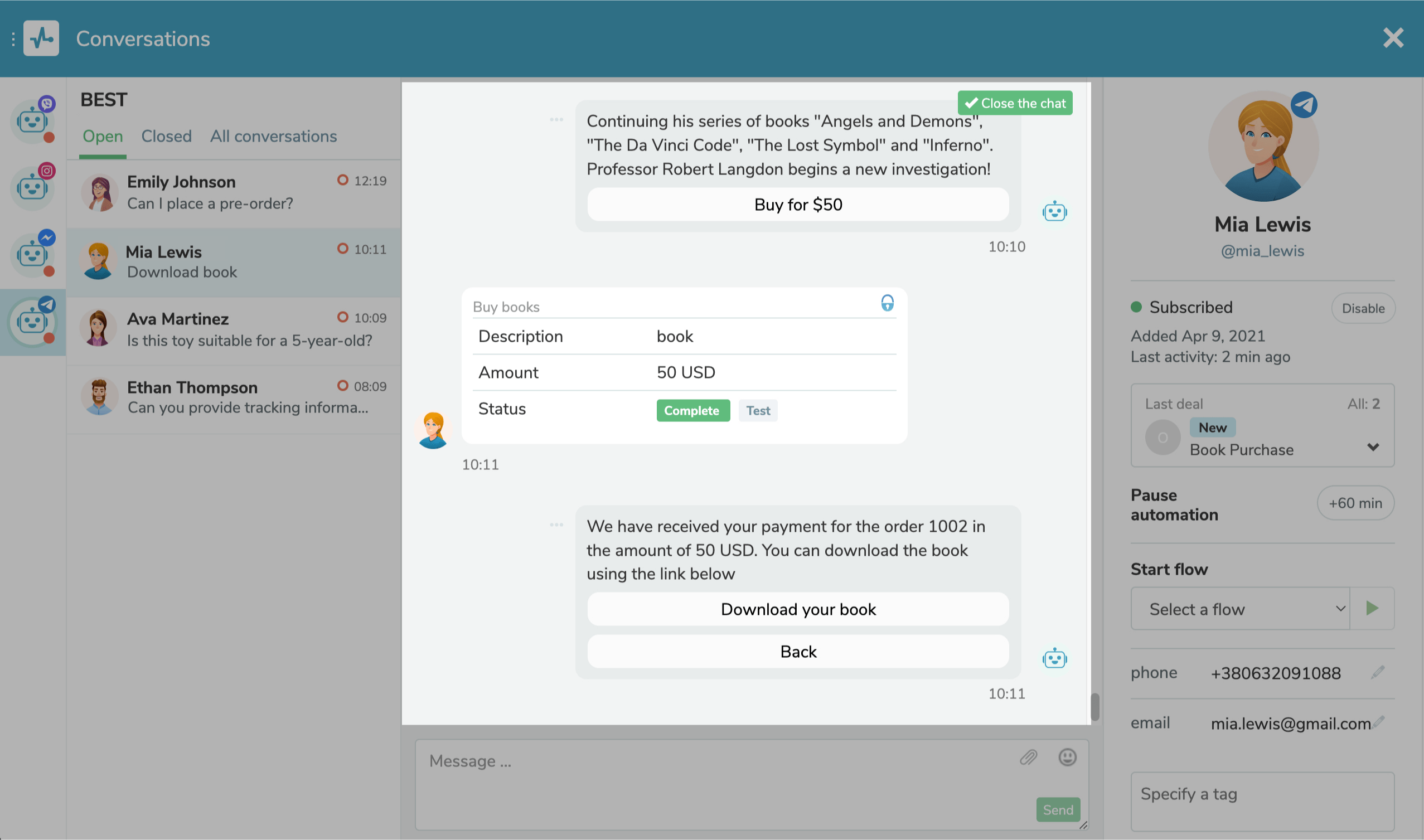
For Telegram chatbots, there will be a link that allows to download files. For Instagram chatbots, you will receive all notifications about Facebook ad clickthroughs and Story mentions in the business account linked to your bot.
You can also see the button a subscriber clicked — it is displayed as a message sent from your subscriber.
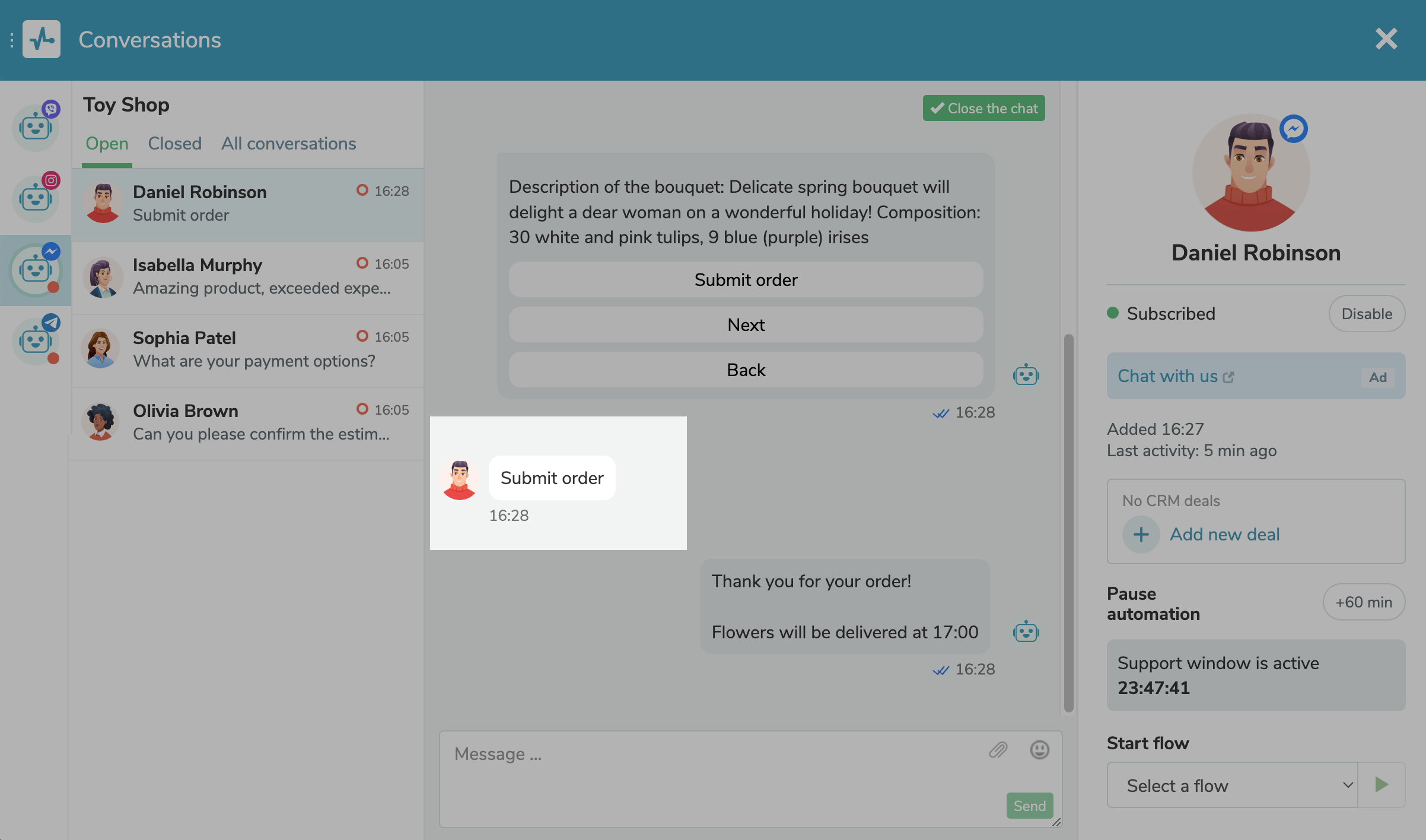
In Instagram, WhatsApp, and Facebook chatbots, you can check message statuses under each message.
| Sent | One gray tick. |
| Delivered | Two gray ticks. |
| Read | Two blue ticks. |
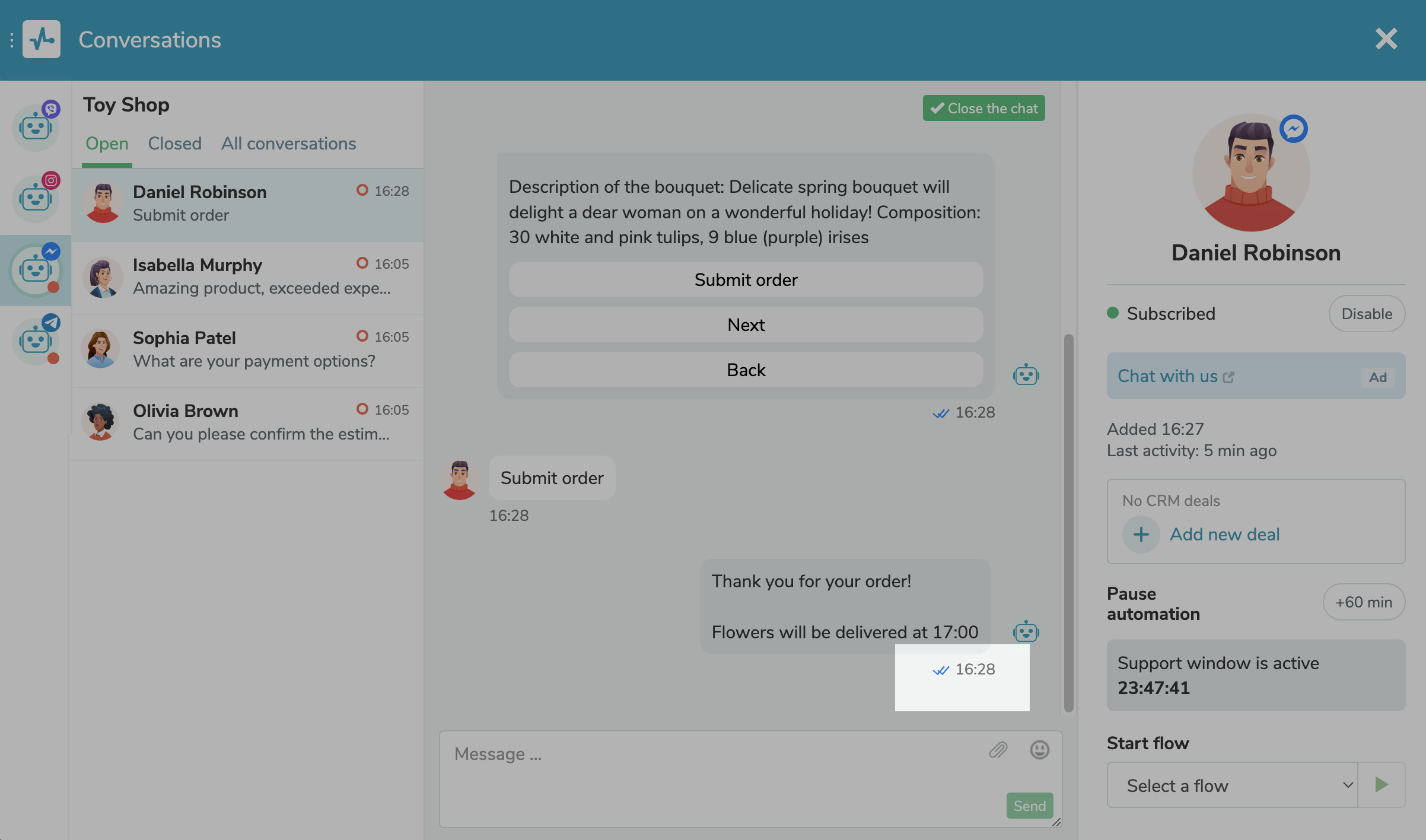
For Telegram chatbots, you can see who sends messages in chats — your bot or admin.
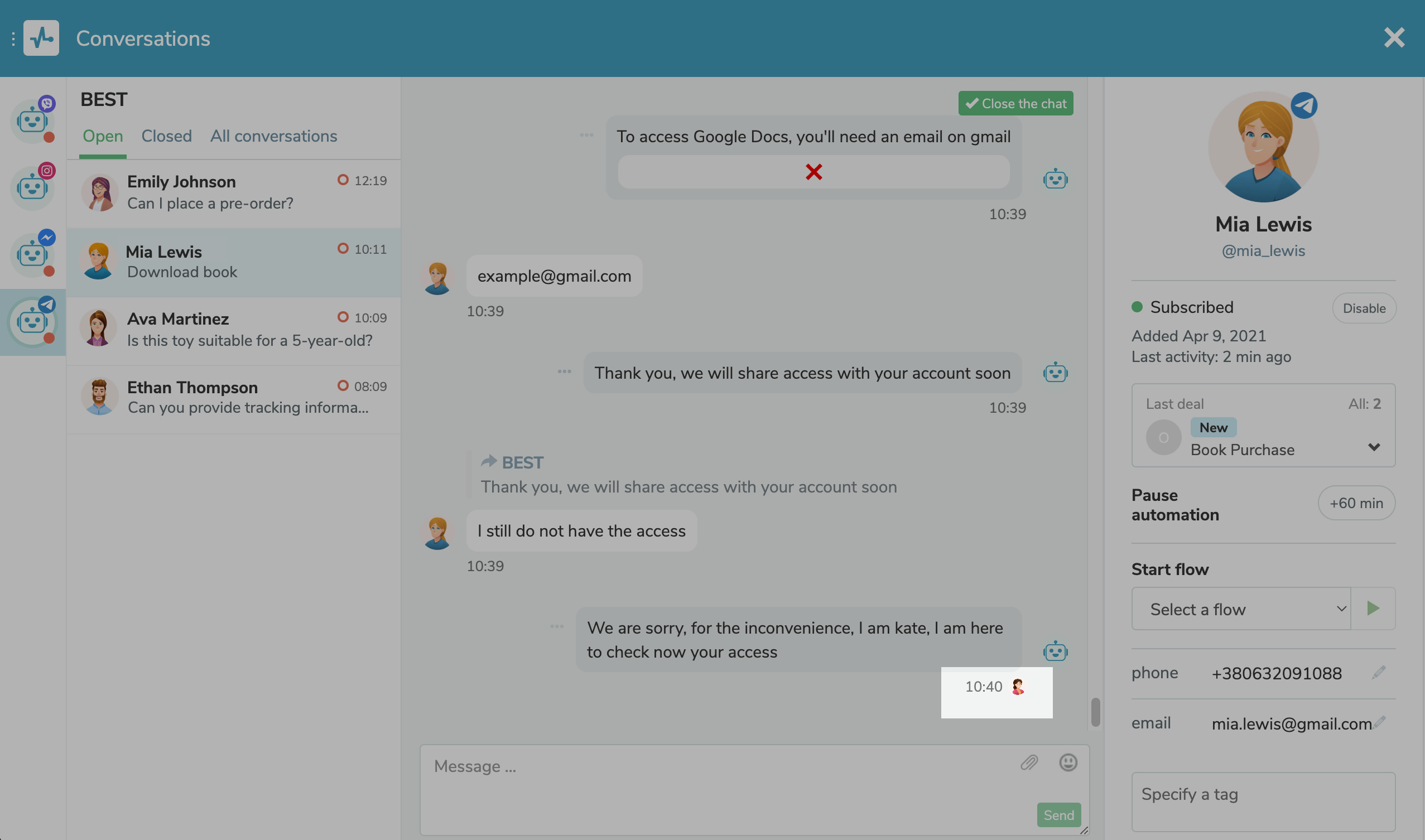
For Telegram chatbots, you can also see if a subscriber’s message was a reply to your previous message. Above your subscriber's reply, you will see a quote of the message they replied to.
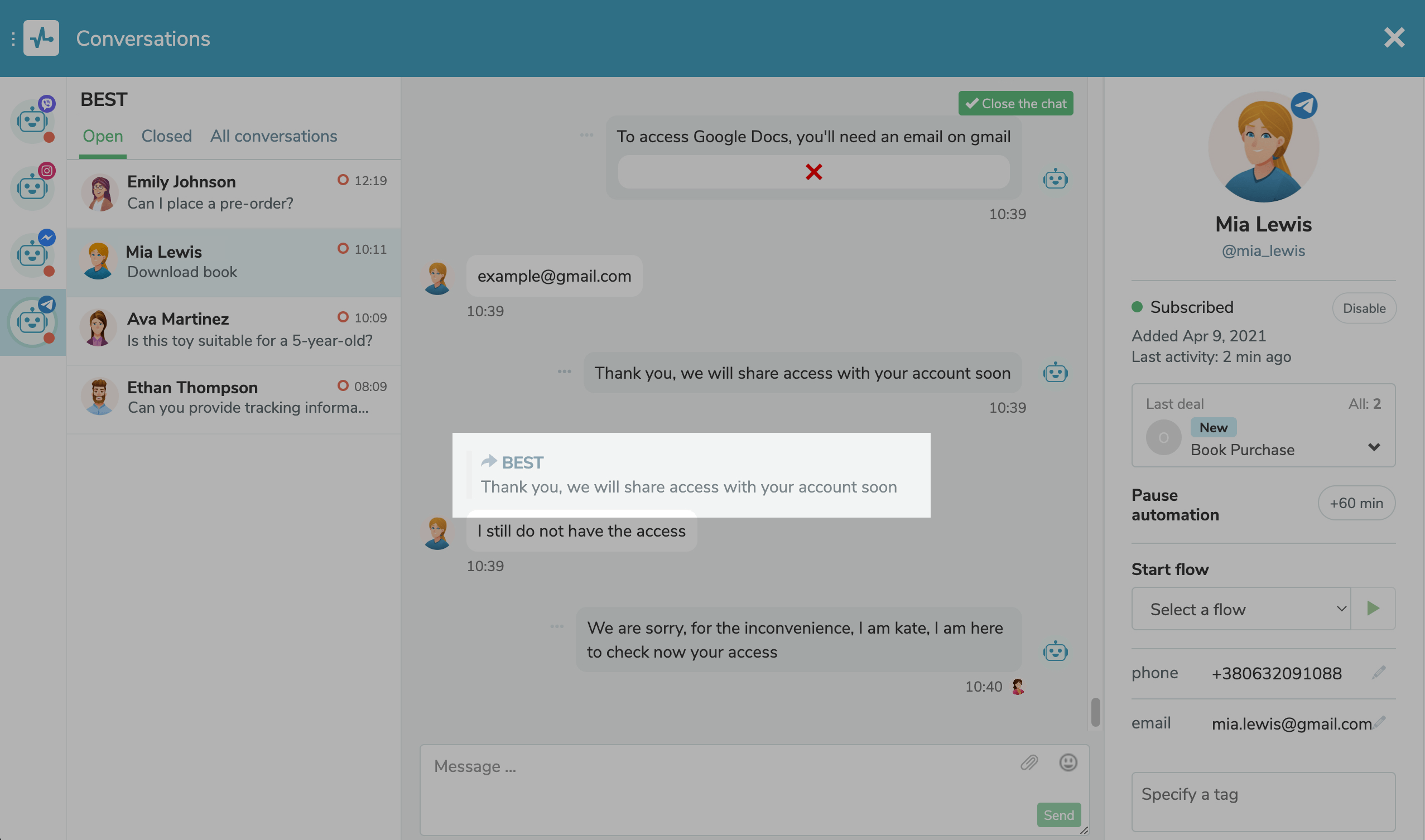
In Instagram and WhatsApp chatbots, you can also see how a subscriber reacts to your messages.
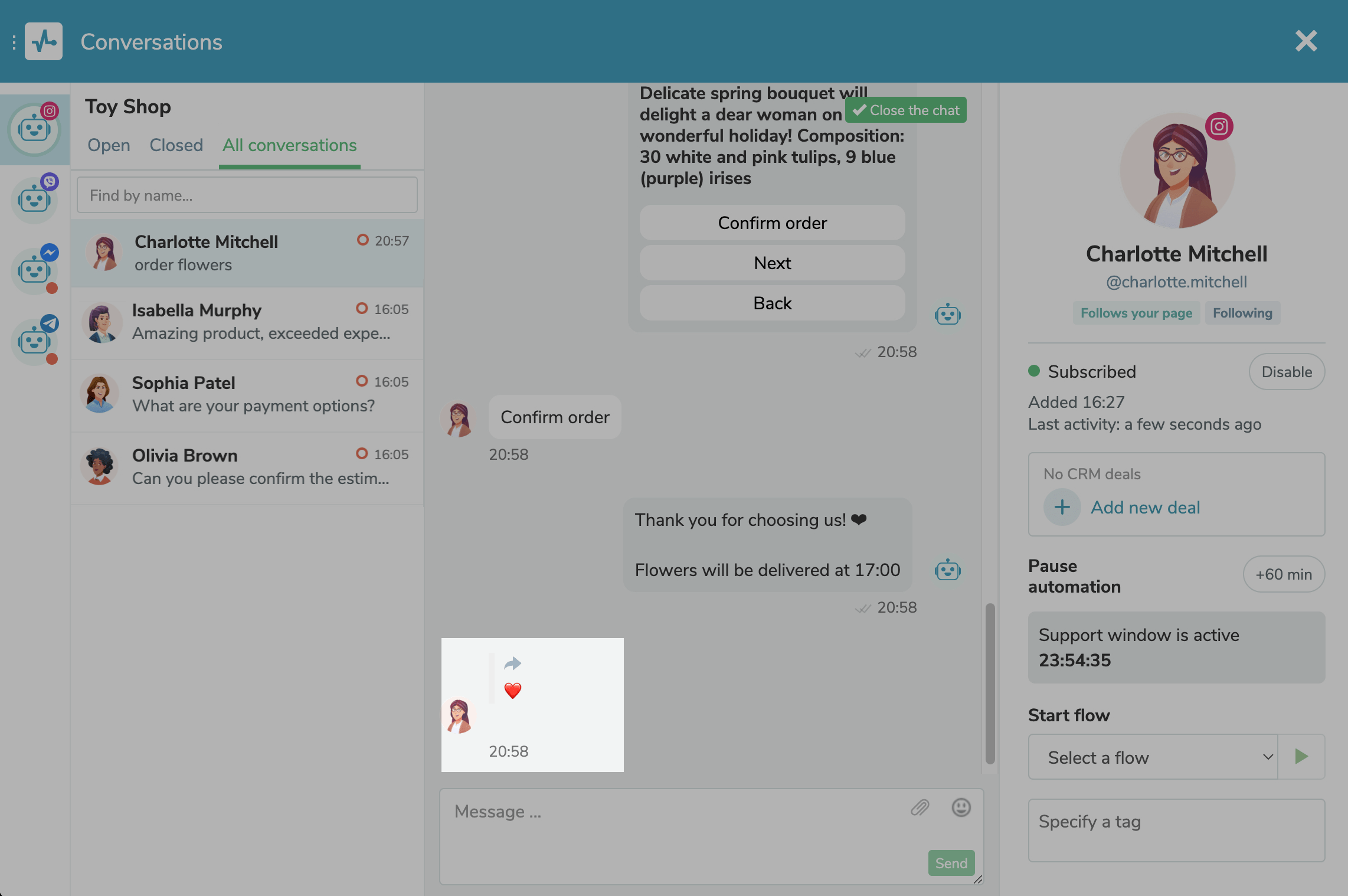
You can delete Telegram bot messages within 48 hours after receiving them. Click the three dots icon to the left of a message, and select "Delete."
Sending Messages
In the upper field, you can reply to your subscriber. Enter a text of up to 512 characters. You can make your conversation more personal and engaging by adding emoji. Also, you can attach files no larger than 20 Mb in size of any format except executable formats. To send a file, click the paperclip icon, and select a file.
Once you create a message, click Send.
If you send a message to a subscriber manually, all automated replies in your chatbot flow will pause for 60 minutes starting from the time you sent your last message. Your subscriber can trigger flows only by clicking your chatbot buttons.
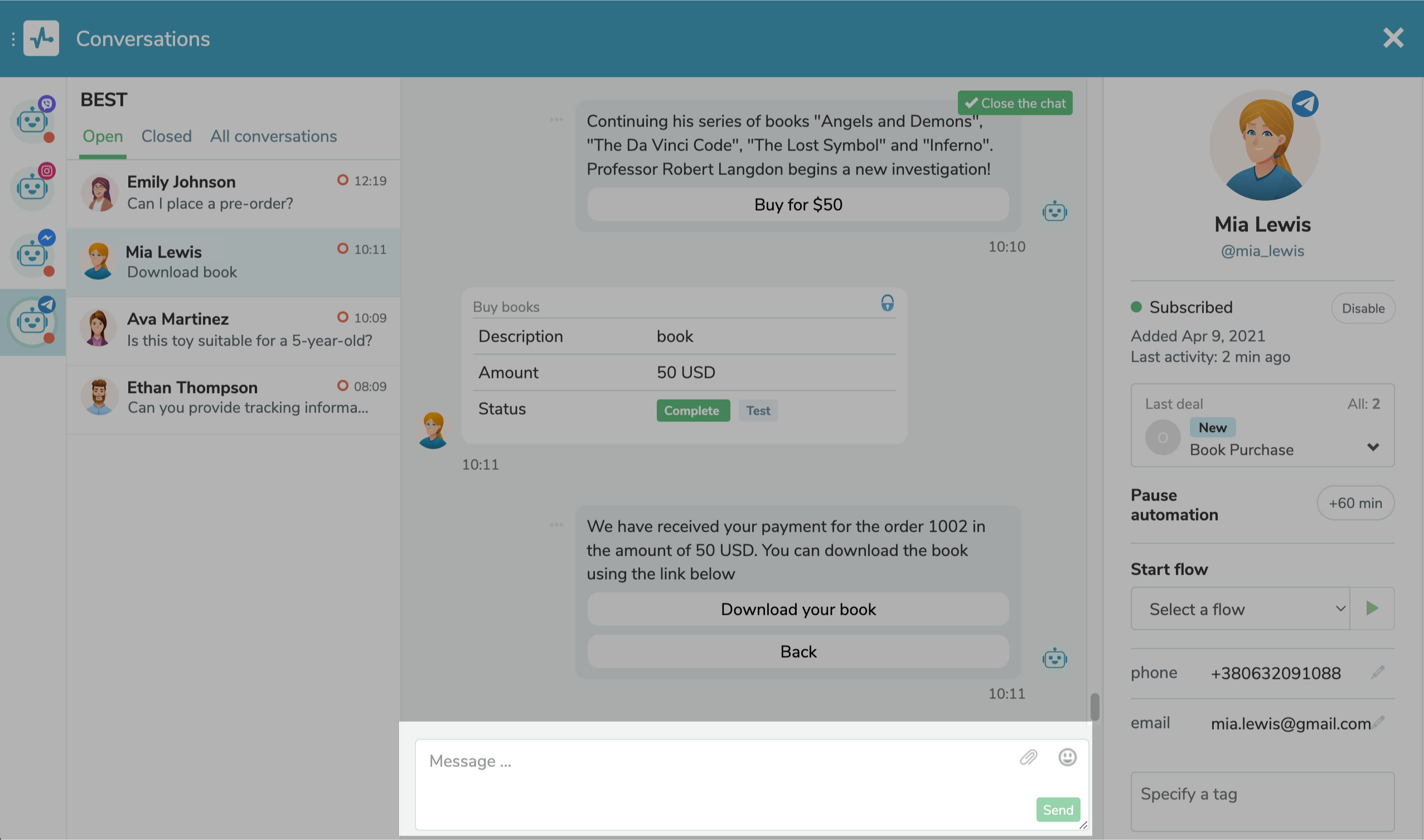
You can reply to customers using different messaging apps manually.
On Instagram, the response window is set to 7 days, while other messaging apps set it to 24 hours.
Outside of the 24-hour window, you can send only pre-approved messages using categories in Facebook Messenger and templates in WhatsApp. With Viber, you can send 10,000 chatbot-initiated messages for free every month.
For Telegram, there are no response time limits.
On the right, you see how much time is left until the end of the support window. Each time a user sends a message, the counter of the 24-hour support window will be restarted.
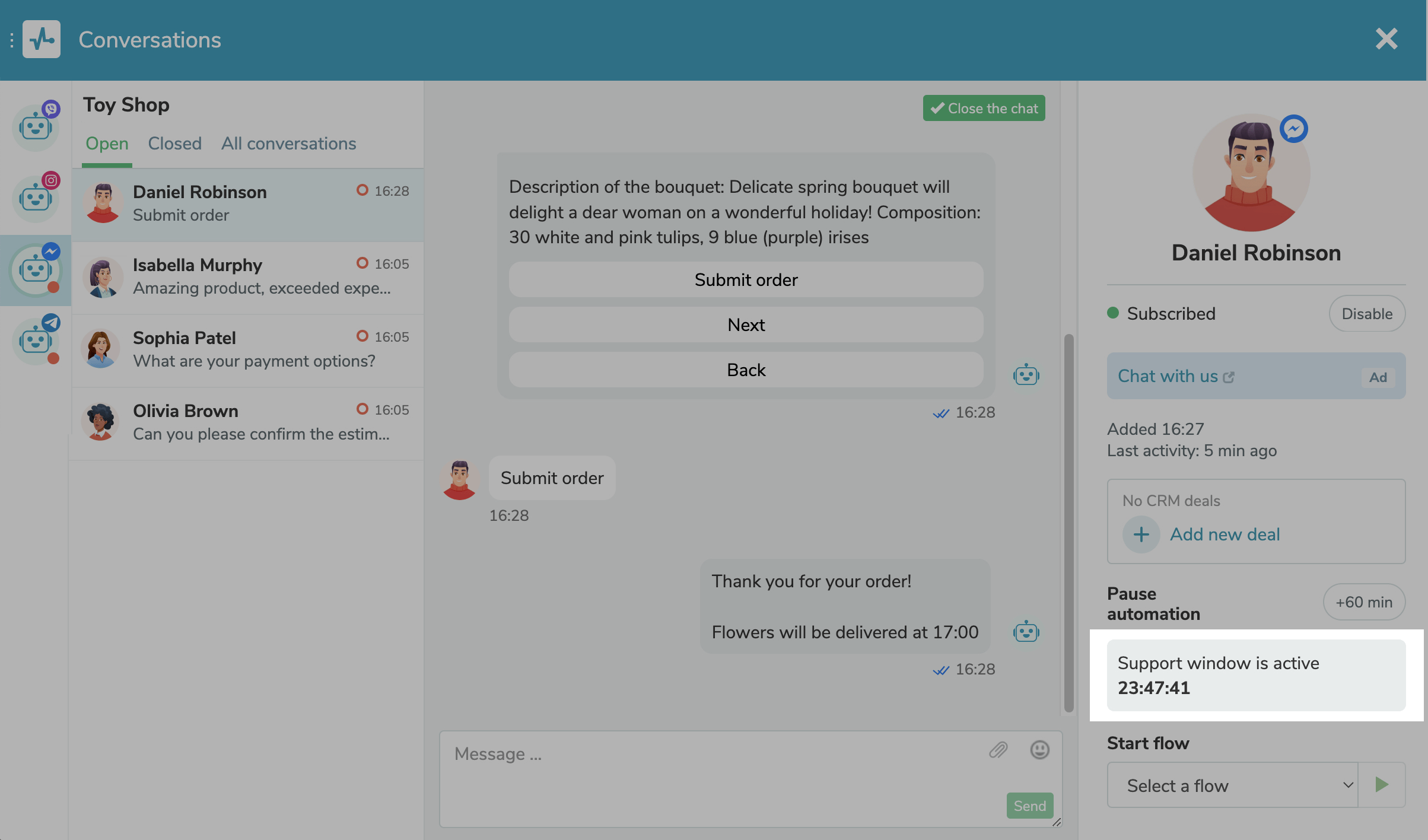
Adding Notes
You can add notes about a contact or share additional info with your team members. Add information about user preferences, specific requests, feedback, reminders about important dates, or other useful comments.
To add a note, in the bottom panel, go to the “Notes” tab. Enter text up to 2000 characters and emoji.
Notes are not sent to users — only you and your team members can see them. Under each note, you can see who added it and when.
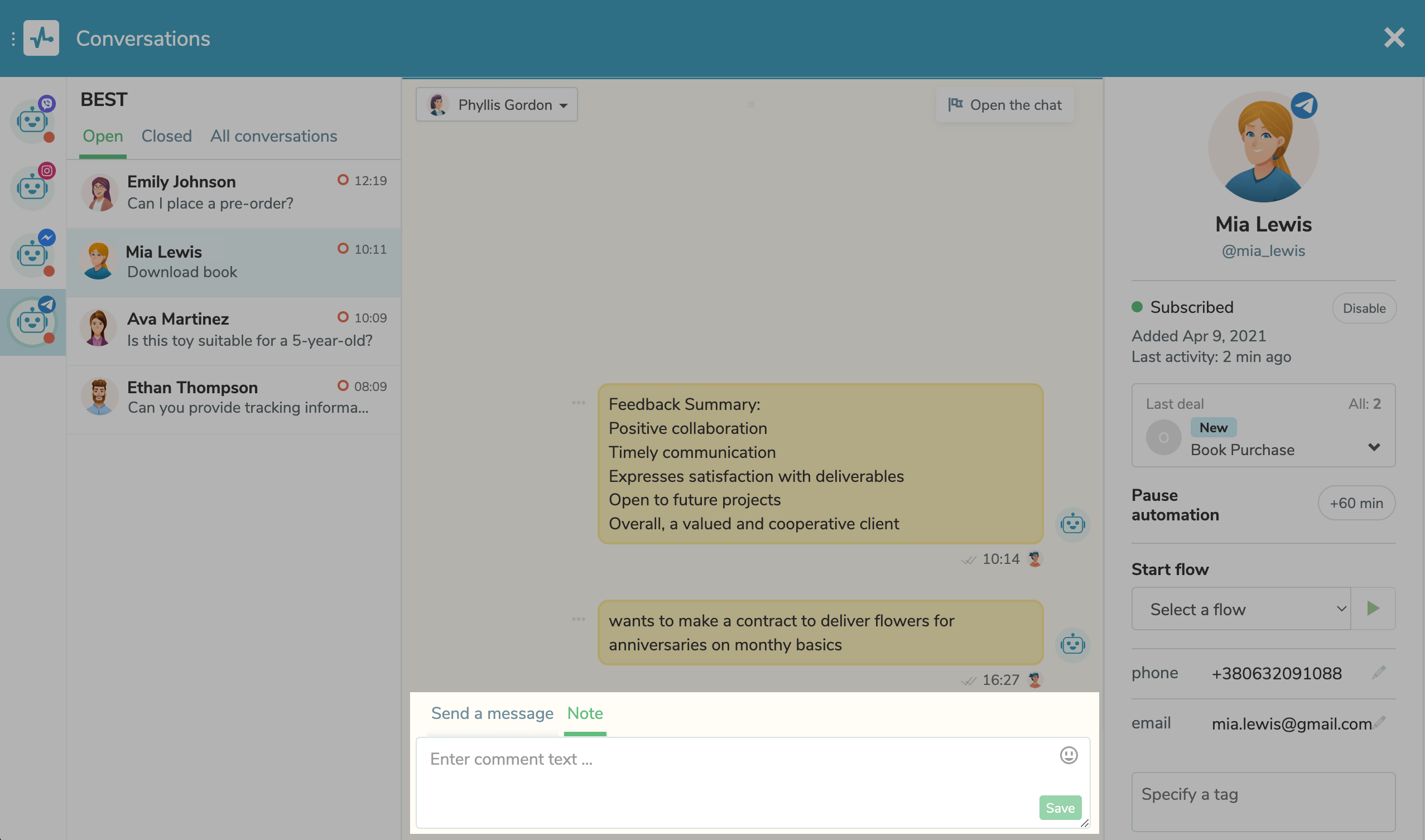
To delete or edit a note, click the three dots to the left of the note, and select a corresponding option.
Assign a Team Member
You also can distribute conversations with users among team members and assign certain contacts to them. The responsible team member will receive a notification via your selected method if a subscriber goes through the “Open chat" element in your chatbot scenario.
To assign a contact to a team member, open a conversation, and select a user in the upper panel.
To select an assignee, you need to invite the user and select a role with access to “Chatbots: Conversations and audience.” Read more: "User Roles."
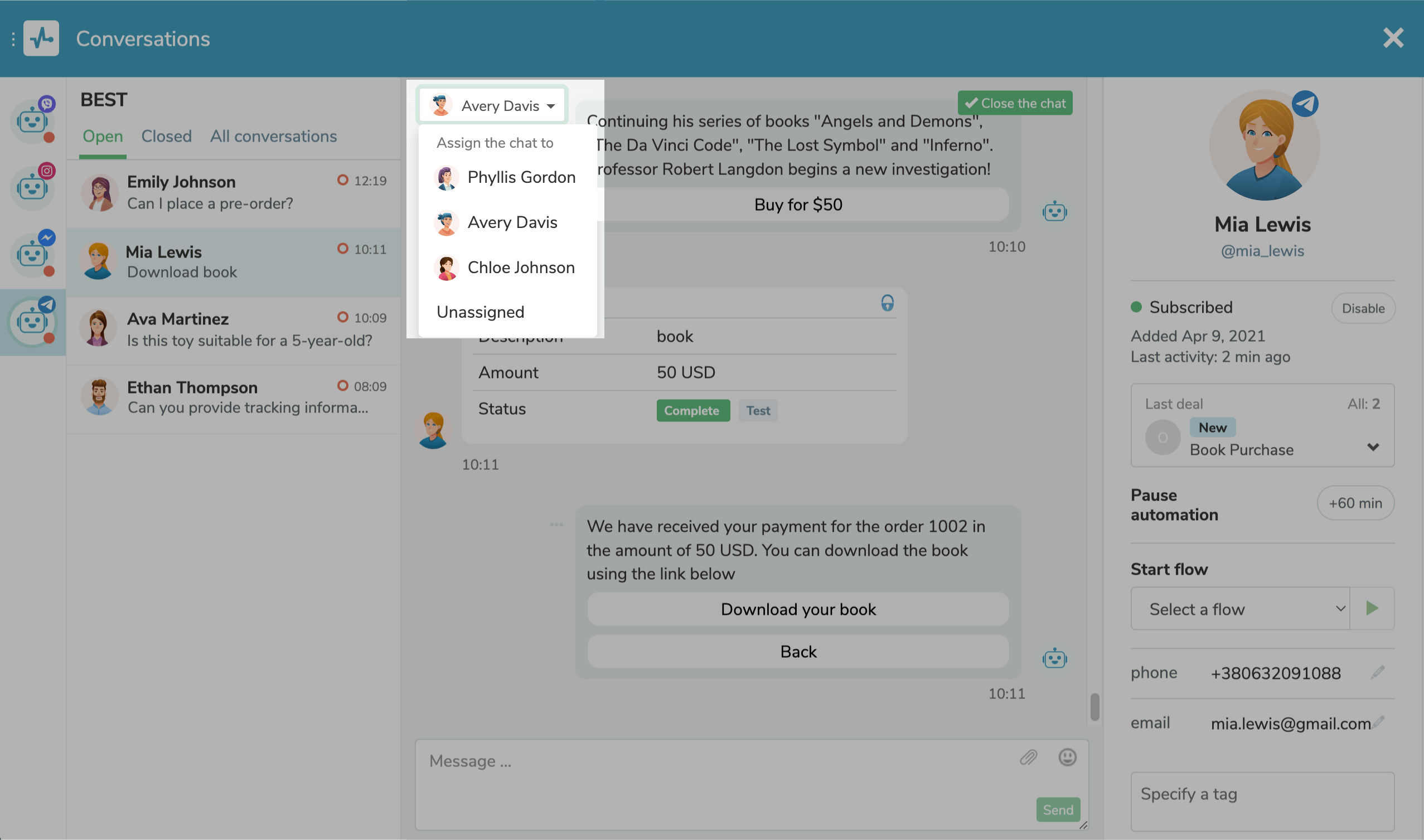
Subscriber Data
Contact Information
On the right panel, you can view the information about a subscriber. At the top, there is their avatar, name, and social media username. Their email address and phone number are stored in variables.
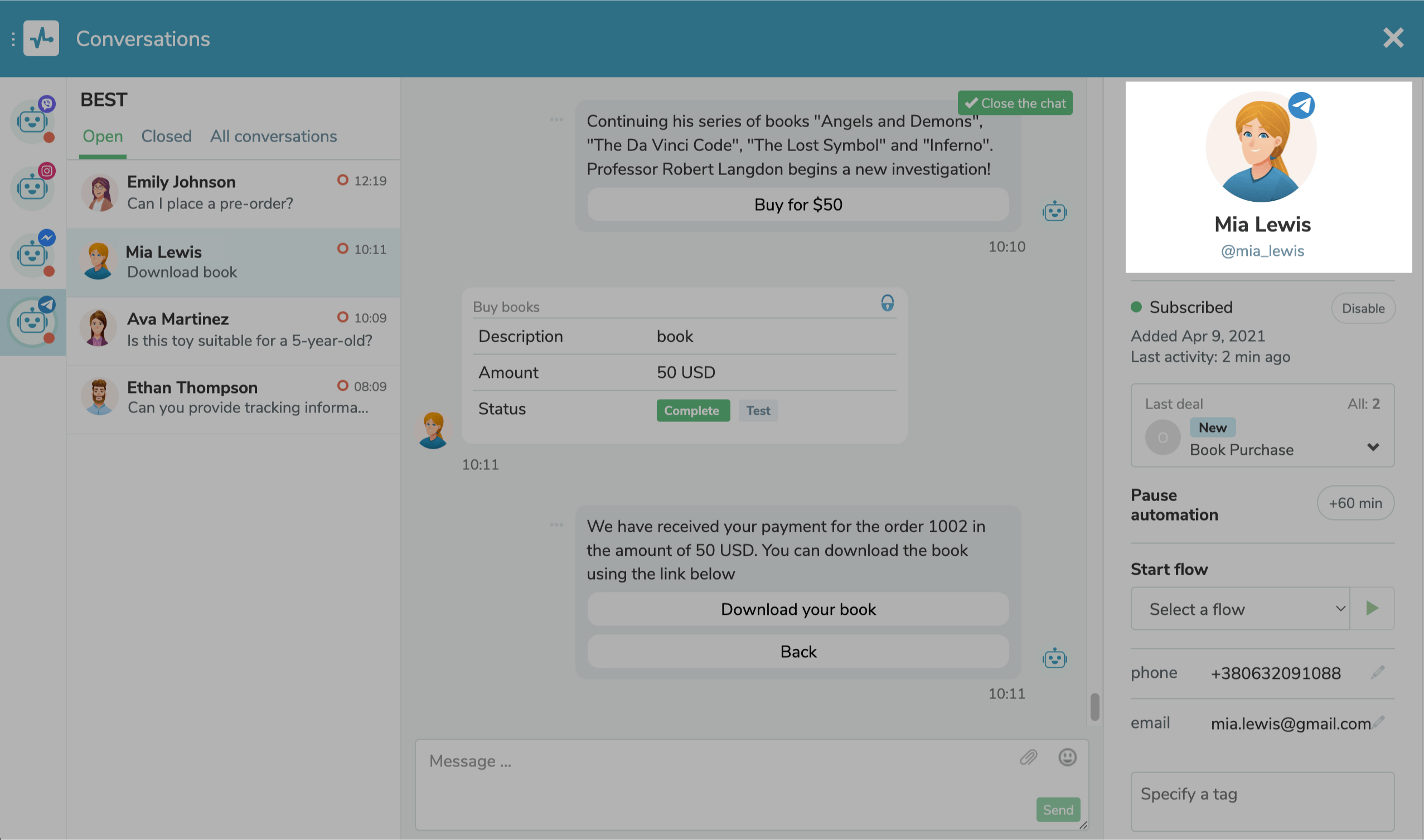
In your Telegram group chat, you can view the number of subscribers and copy the share link or invite link.
Bot Subscription Status
Under a user’s avatar and name, you can see their bot subscription status, the date when they subscribed, and the last activity time.
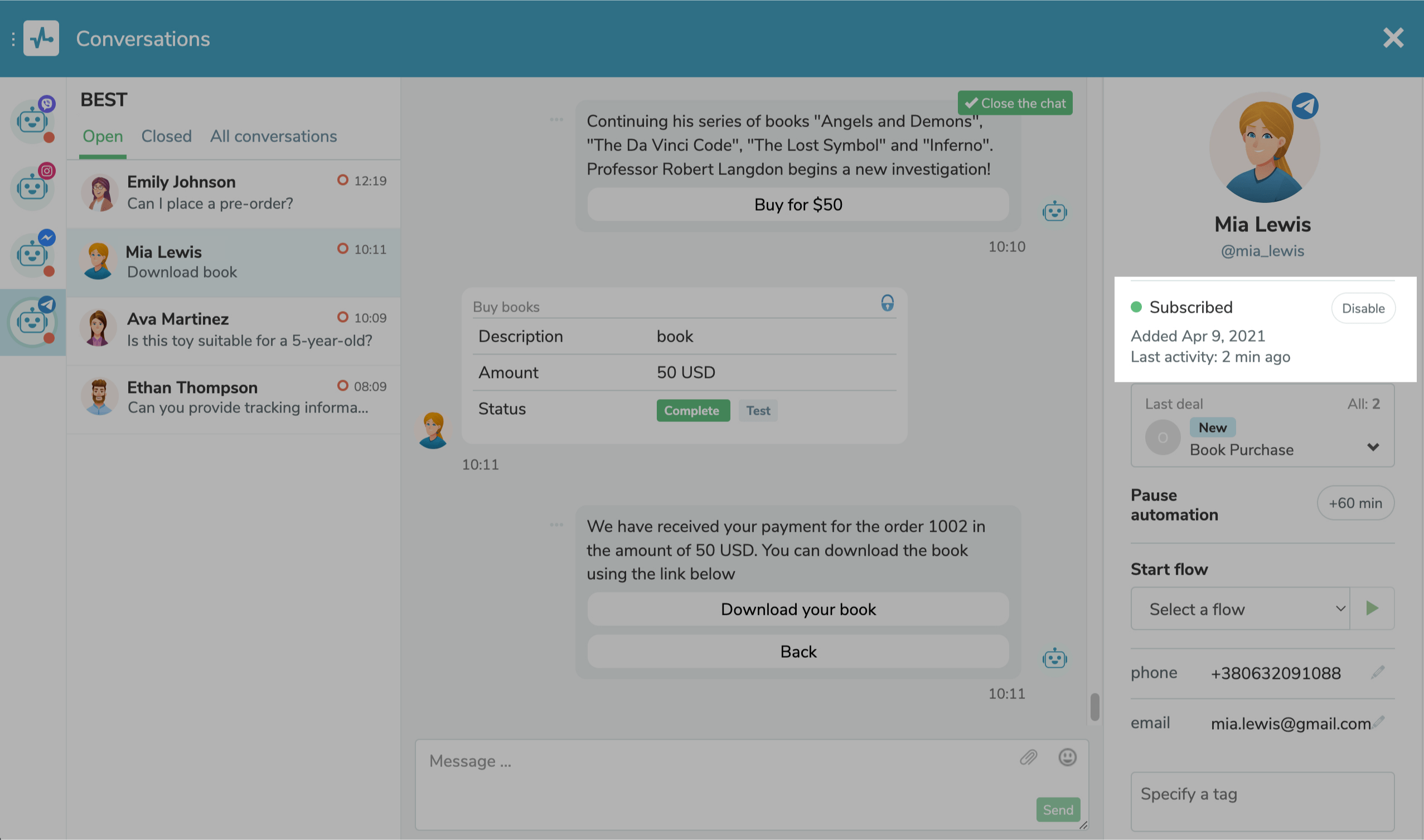
Instagram Subscription Status
In chats with Instagram chatbot users, you can see the status of their subscription to your Instagram profile and your subscription to users' profiles.
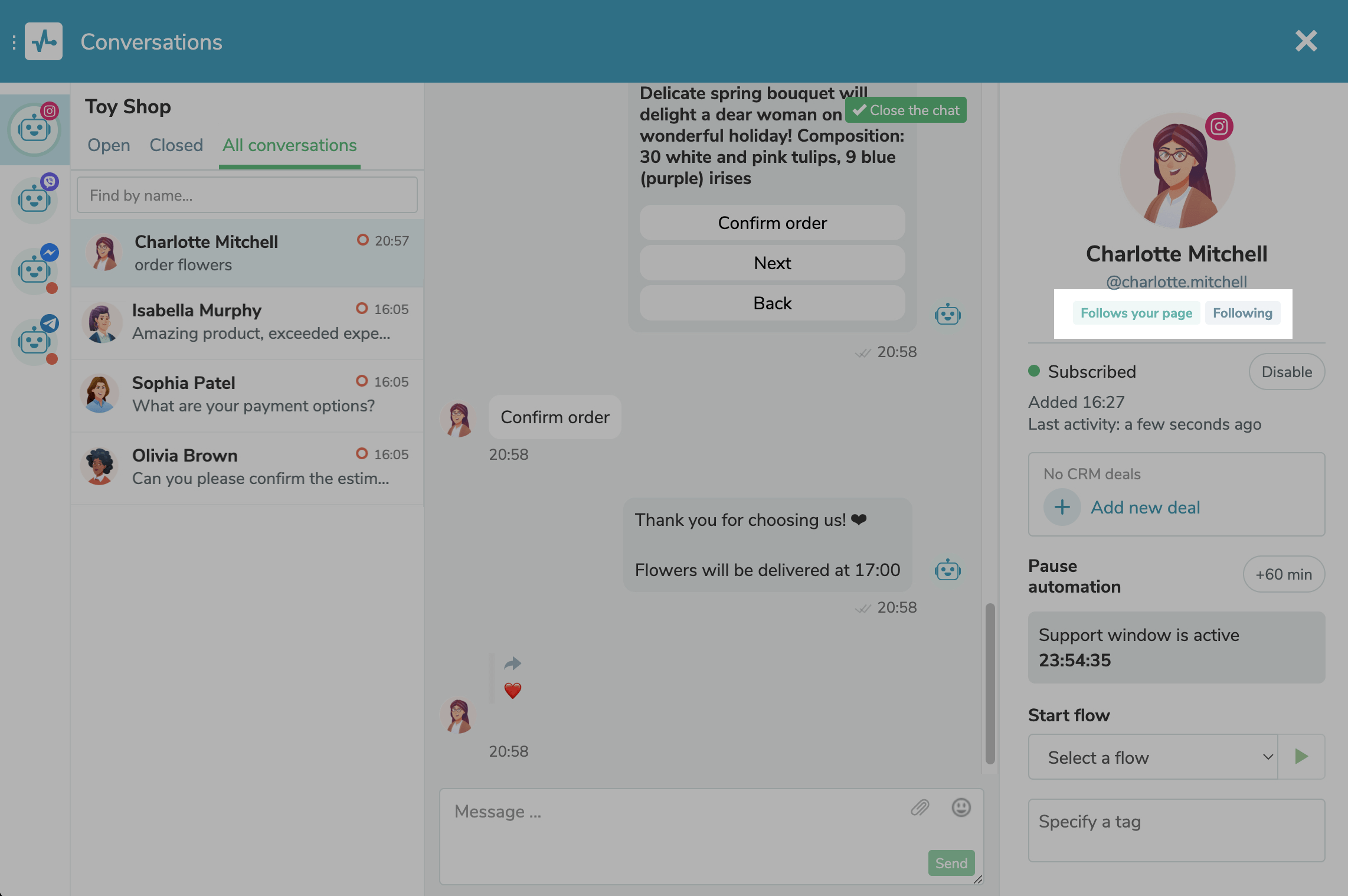
Facebook Ads
In Facebook Messenger, Telegram, and Instagram chats, you can see which advertising campaign your subscriber came from.
In the "Advertising campaign" field, you will see the advertising campaign name listed in your Facebook account. When you click the link, you will be redirected to a page where you can view your ad.
If a user sends you a message after viewing your Facebook or Instagram ad, their message will be displayed as a response to your corresponding ad campaign.
Read also: How to Create a Facebook Messenger Ad and Launch the Chatbot It Links to, How to Сreate an Instagram Ad via Facebook to Run a Сhatbot, How to Сreate a WhatsApp Ad via Facebook to Start a Сhatbot Conversation.
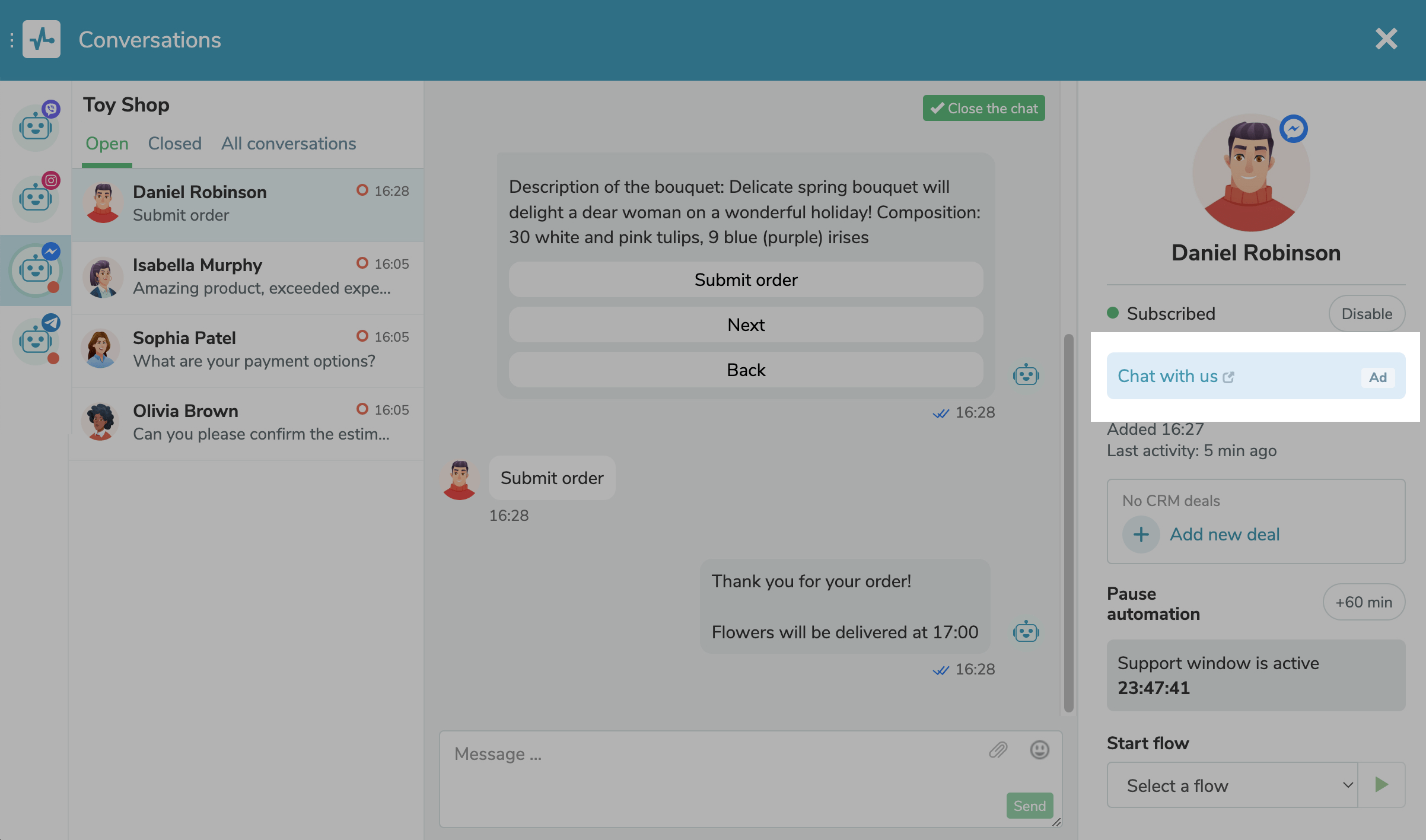
Manage User Data
If you have identified a client's specific preferences during a conversation, you can assign variables and tags to personalize future interactions with them.
Editing a Variable
To edit a variable, click the pencil icon next to the variable, and add a new value.
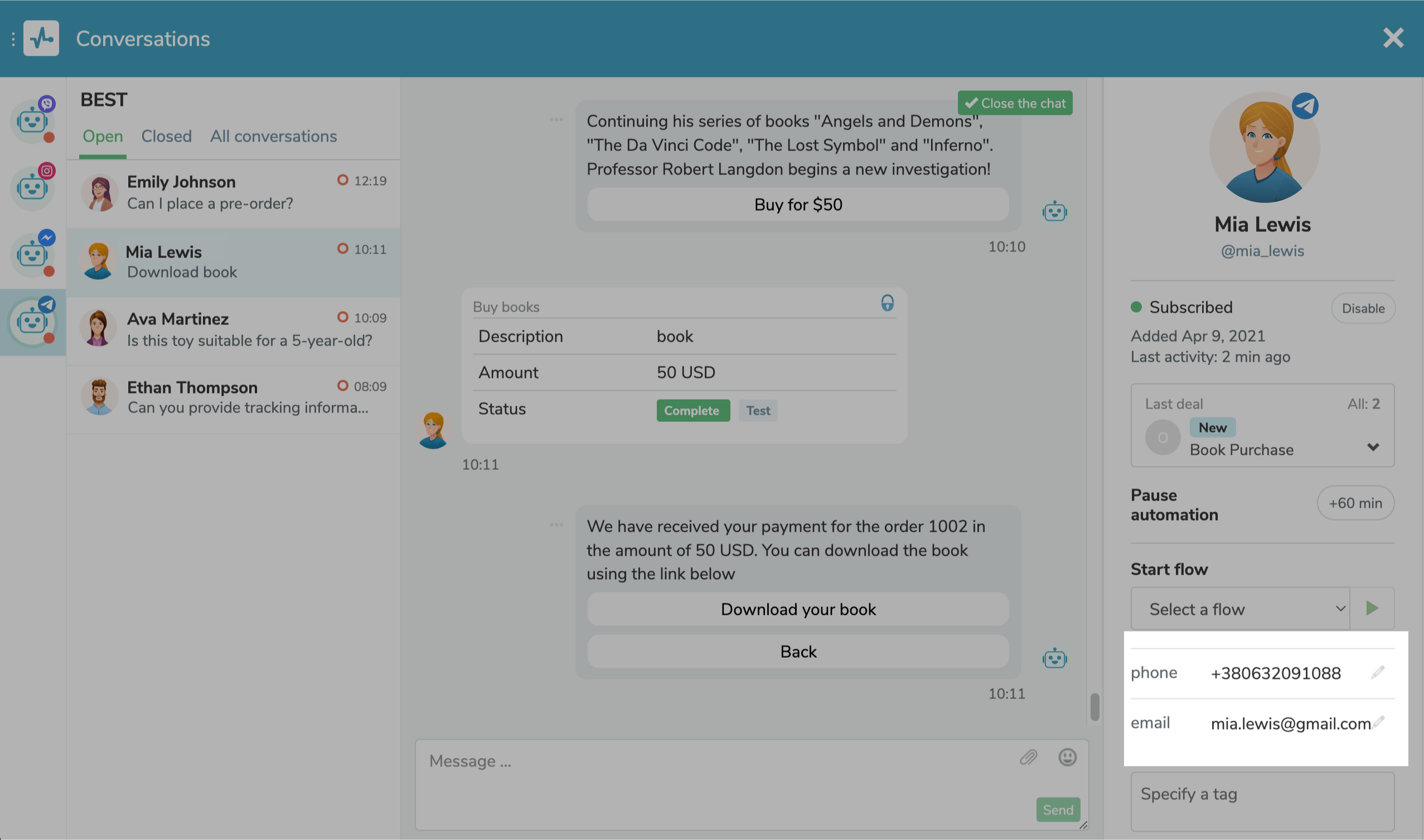
Assigning a Tag
To assign a tag, click a field, and select a tag.
Read also: How to Manage Chatbot Subscribers and Their Data.
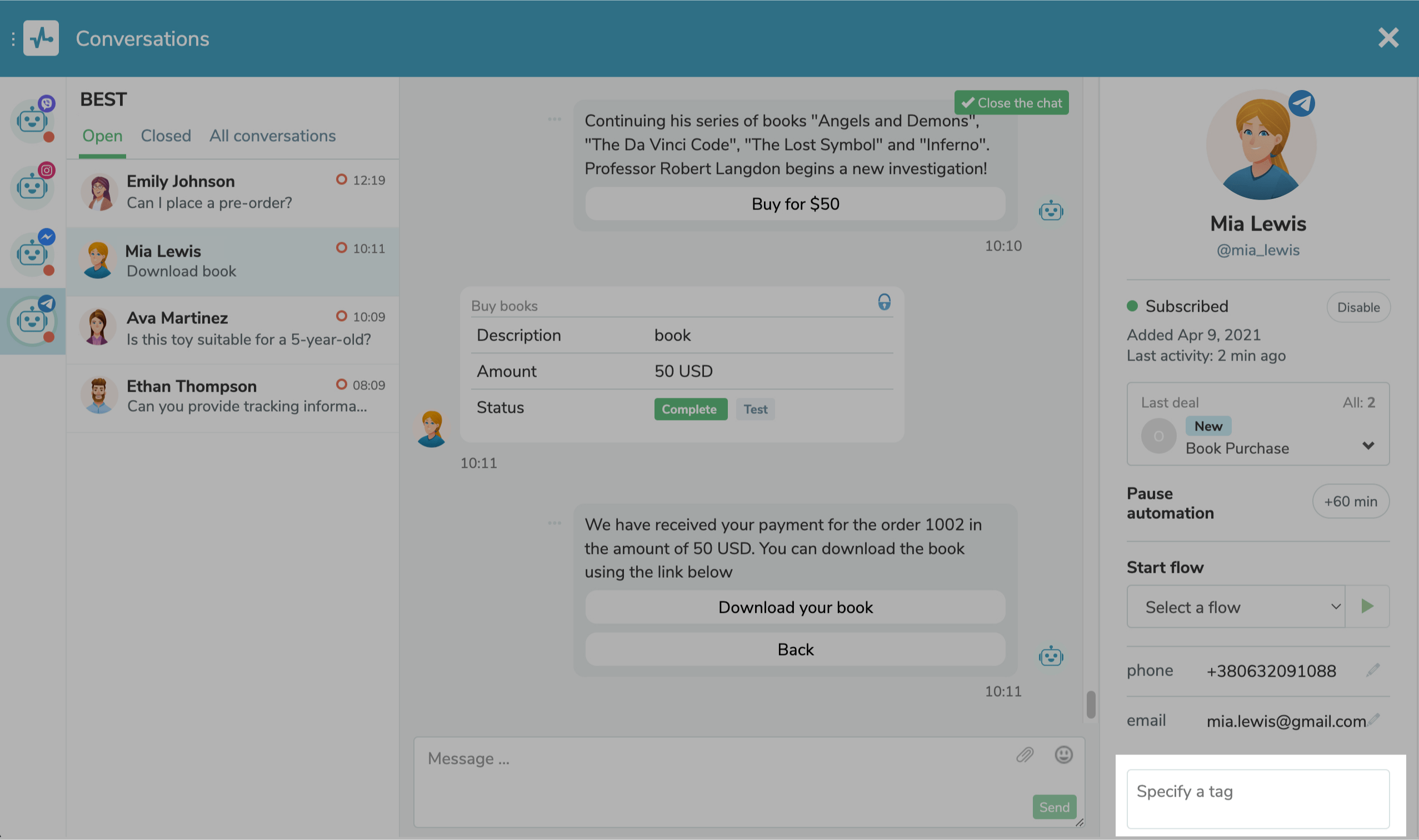
Manage Automated Replies
Launching an Autoflow
To launch a specific flow for any chatbot subscriber, in the “Chats” tab, select a user and a flow you want to start for them.
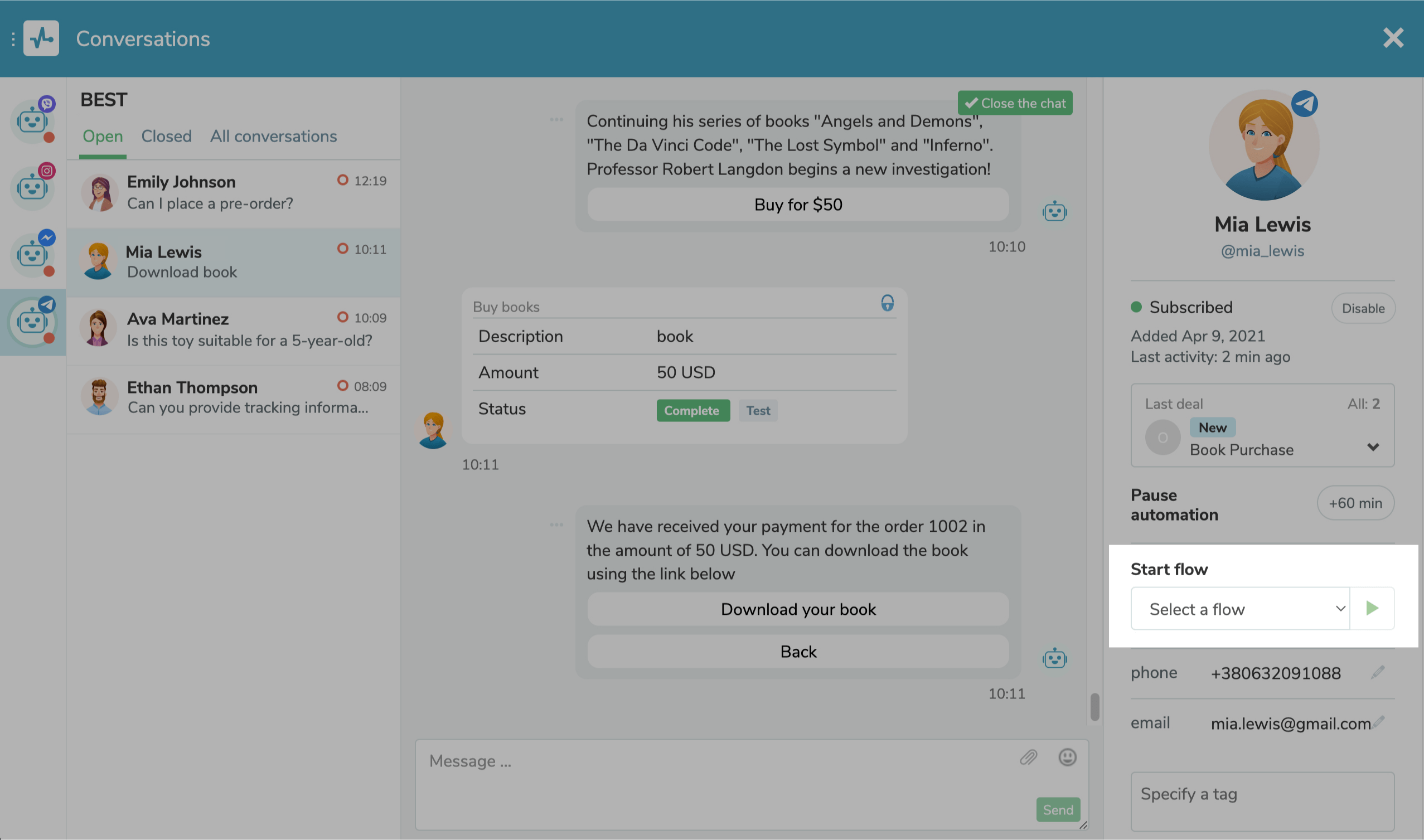
Temporarily Pausing a Bot
There is also an option to stop messaging your subscribers for 60 minutes in automated flows and bulk campaigns. You can extend the pause if you have replied to a subscriber manually and want to pause your flow for another hour. To do this, click +60 min in the Pause automation section.
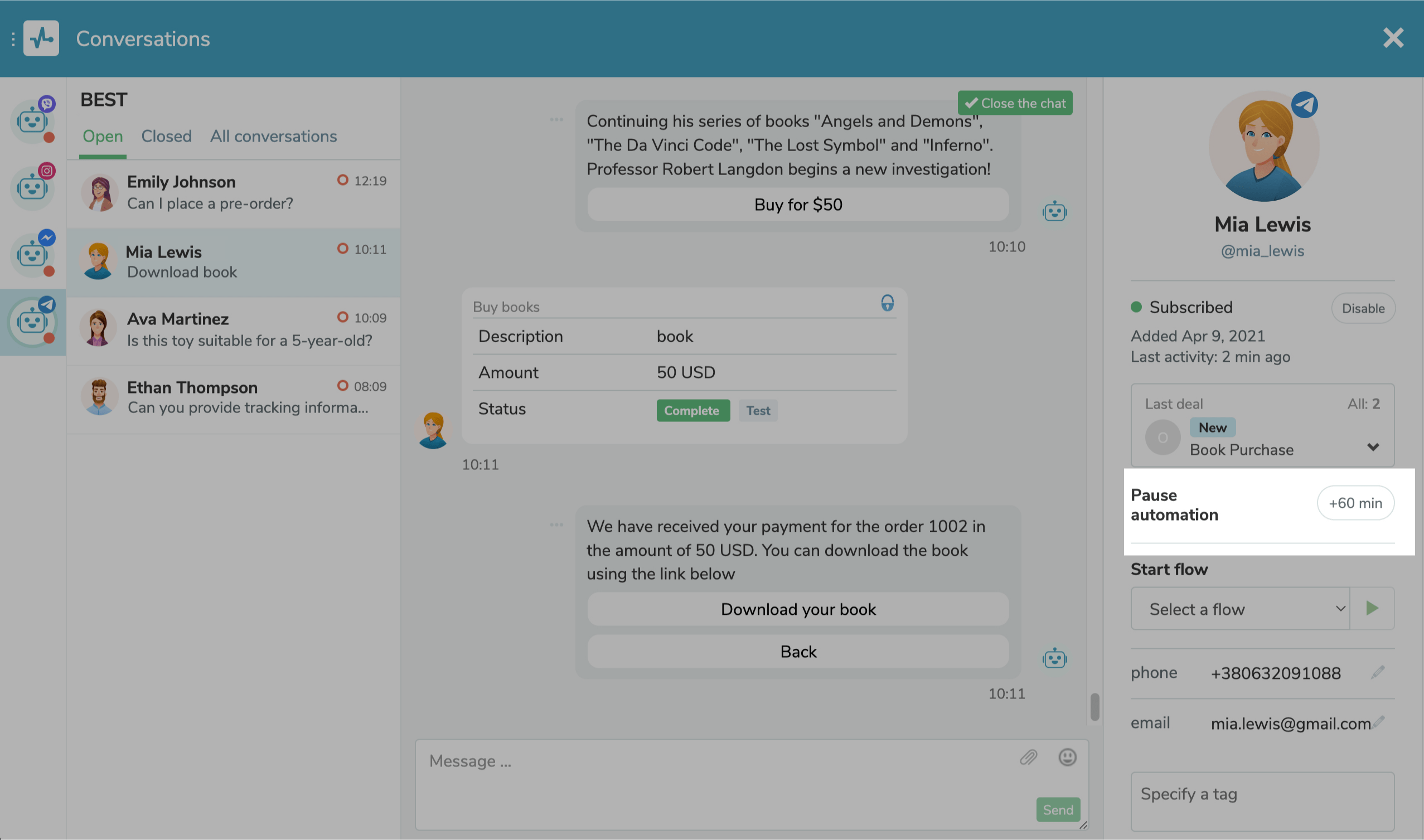
If you finish communicating with your subscriber sooner, click Continue Autoflows.
In the chat, you will also see your active flow with queued messages. You can stop the flow and send another one.
This way, you will help users who cannot find the information they need and are confused by your bot scenario.
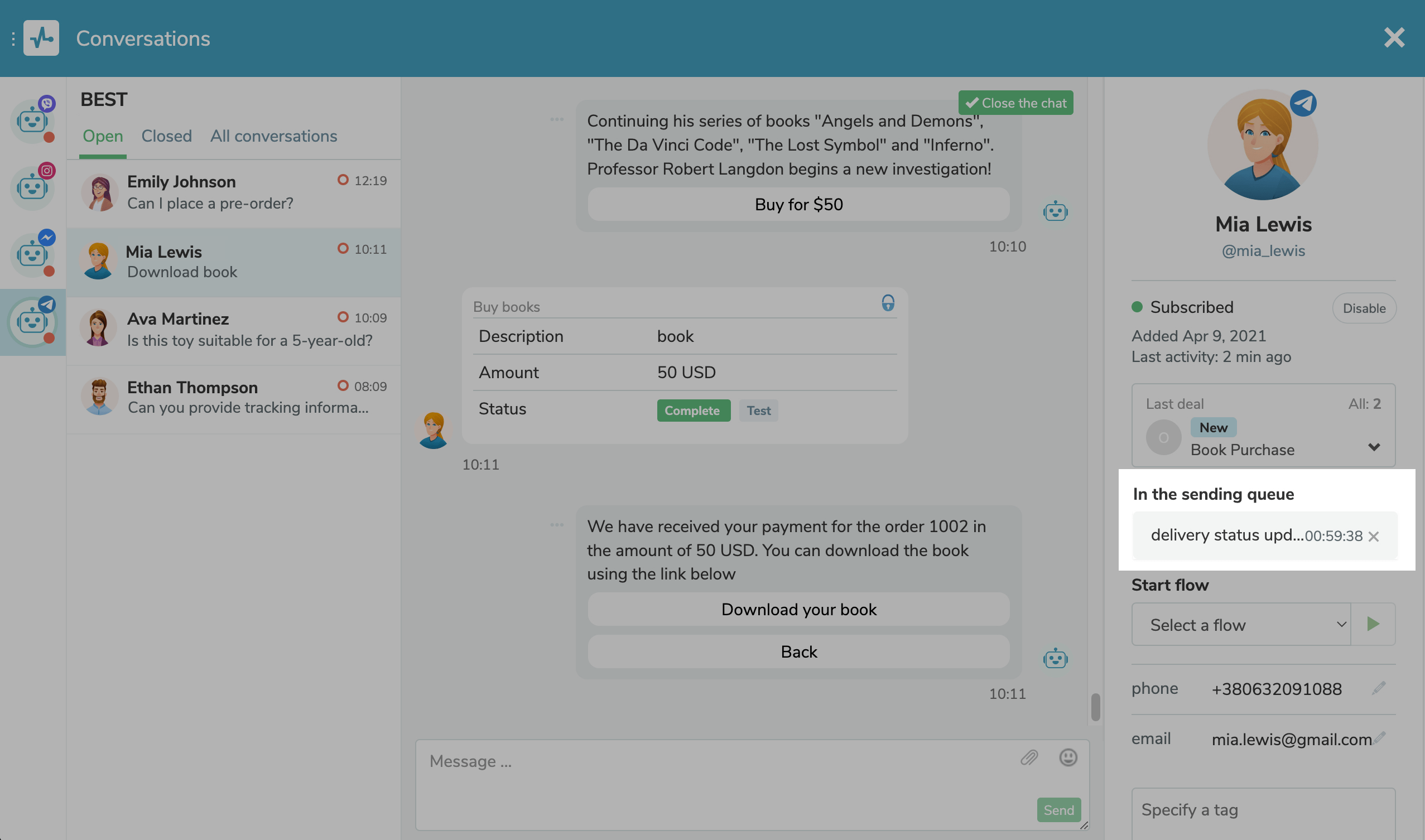
Disable Sending Messages
You can also disconnect a subscriber to stop sending them messages from your bot. To do this, click Disable next to your subscriber's status.
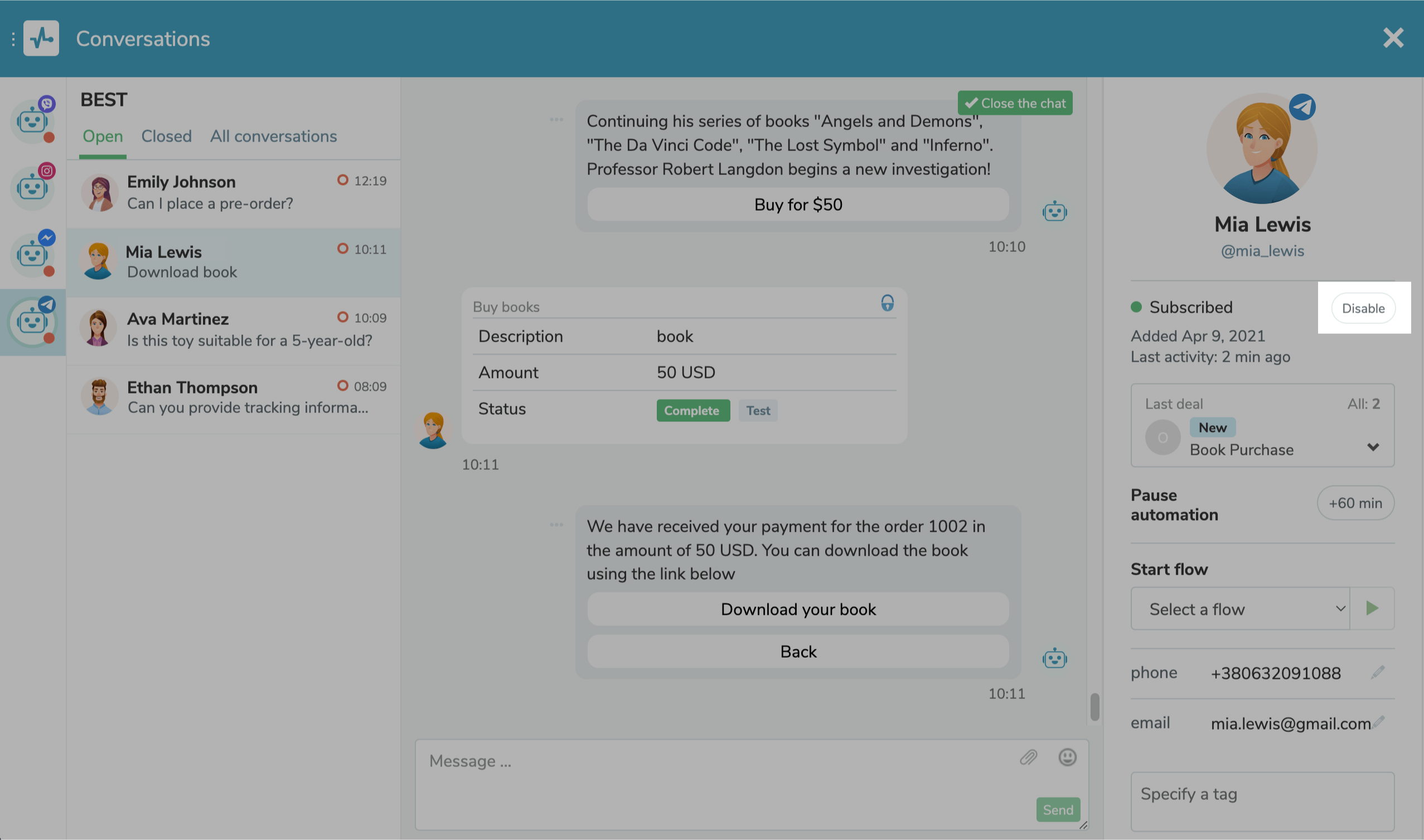
Manage Data in CRM
If you learn new information during a conversation with a user, you can add or edit their deal and contact info in your CRM system.
To view and edit data, go to the "Deals" section. If a user made a purchase using your chatbot, there should already be a created deal and a contact card linked to them.
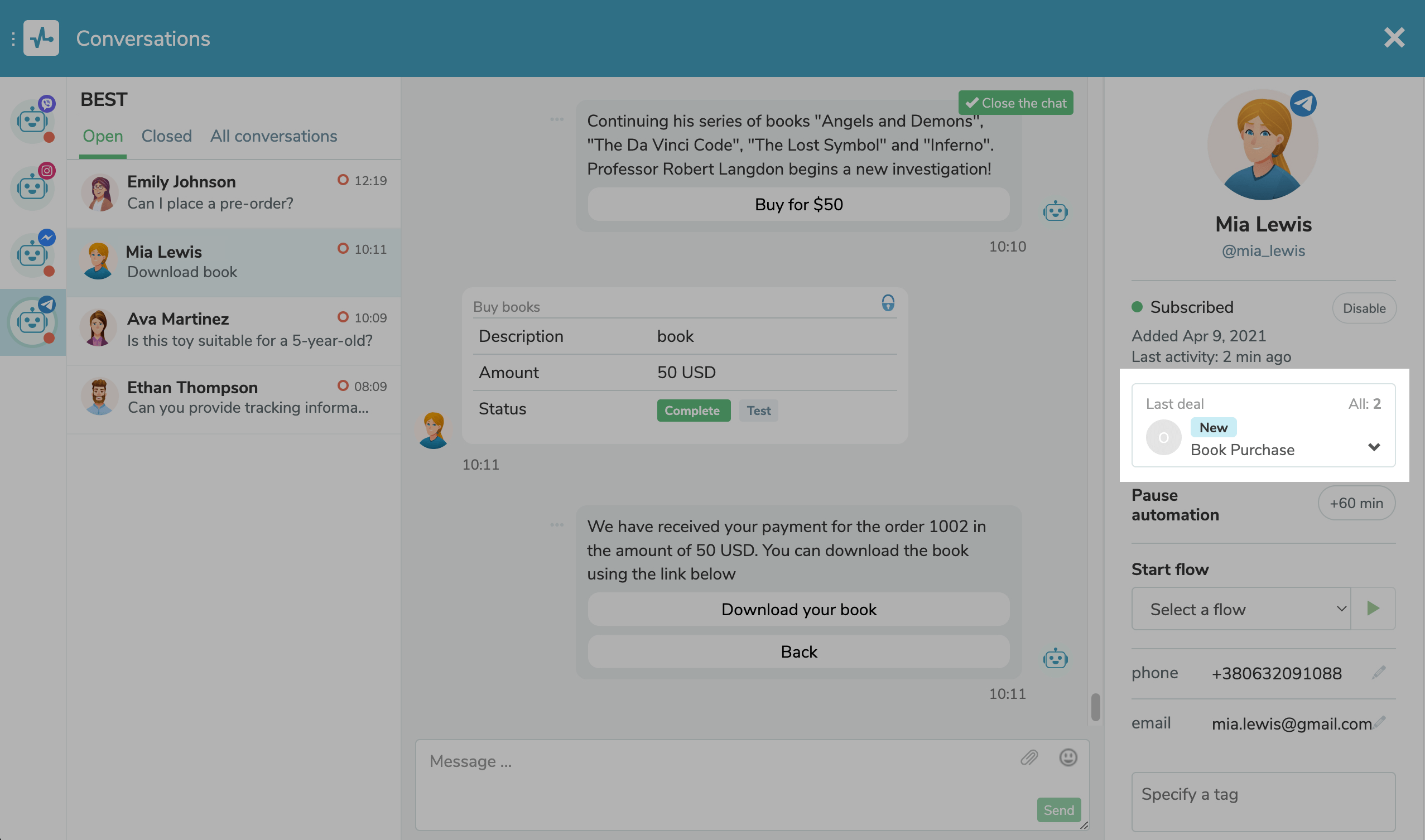
To edit contact information, hover over a contact on the right, and click the pencil icon. You can edit a user’s first name, last name, and phone number.
To add a new deal, click Add Deal, select a pipeline and a deal stage, and enter a deal name and deal amount.
To edit your existing deal data, hover over a deal on the right, and click the pencil icon. You can edit a deal stage, name, and amount. To go to a deal card, click the corresponding icon.
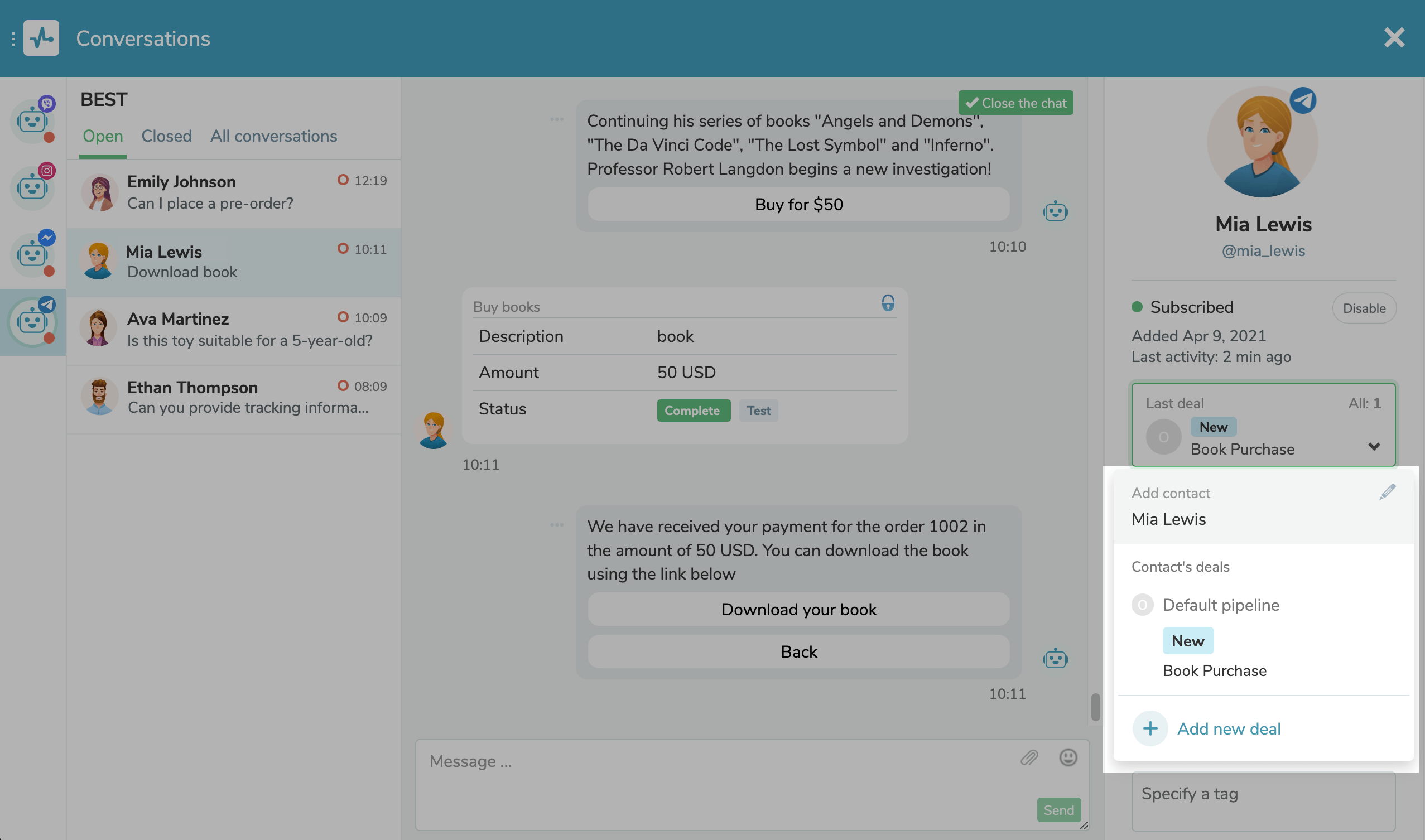
Notifications About New Chats
To receive notifications in your email about the last open chat, select the appropriate option in the "Notification settings".
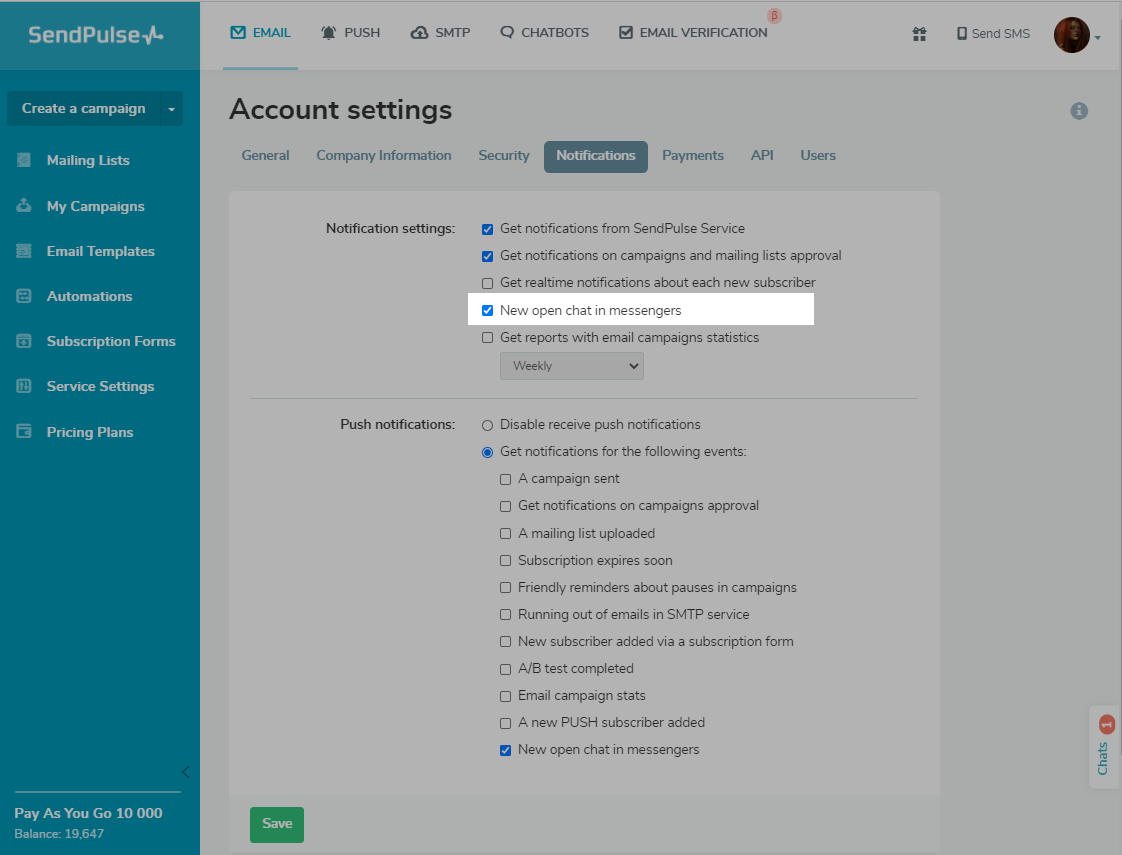
The notification is sent a maximum of once an hour with the last message from the subscriber.
Web Push
You can also receive web push notifications about new open chats. To do this, allow notifications from SendPulse in the browser and select the "New open dialog in messengers" checkbox in the SendPulse account settings on the "Notifications" tab.
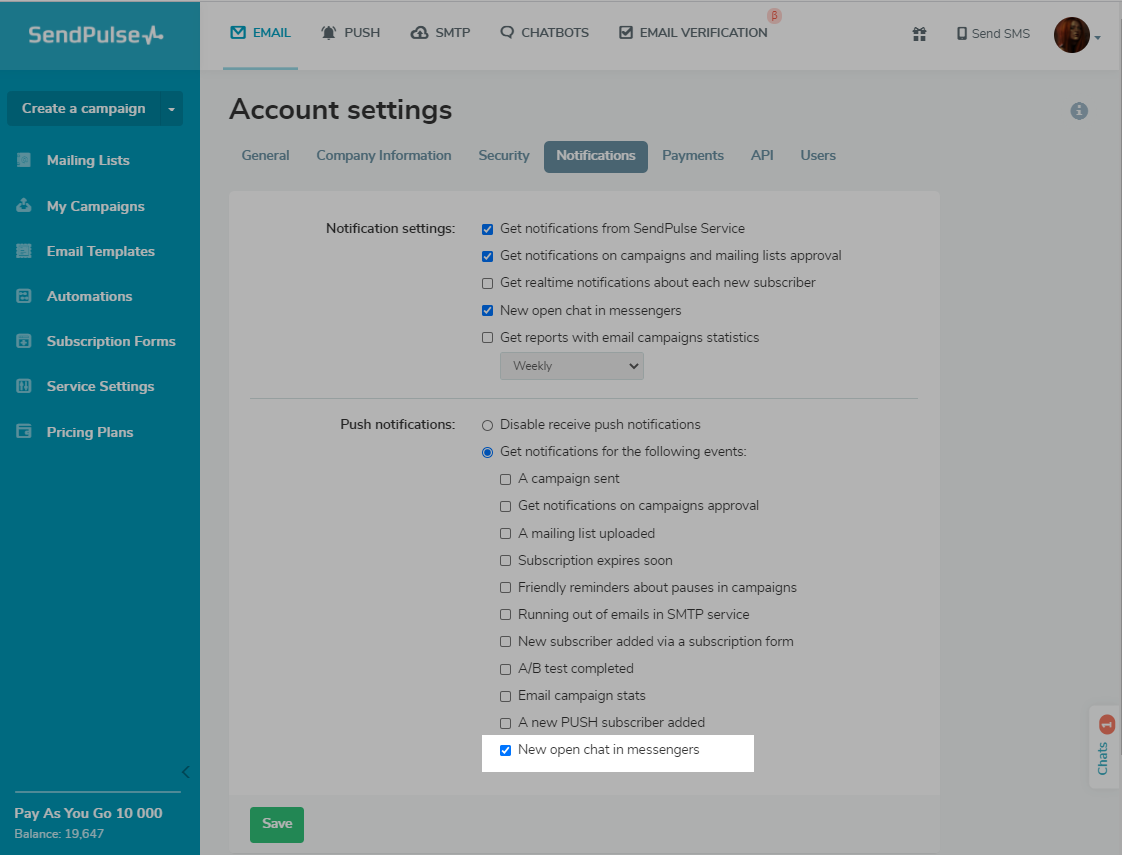
By clicking on the web push notification about the new chat, you will immediately open this chat in your SendPulse account.
The “SendPulse Notifications” bot
You can also receive notifications via the “SendPulse Notifications” bot. To do this, enable bot notifications in your chatbot settings, and subscribe to the “SendPulse Notifications” bot.

If a subscriber messages your chatbot on their own, not through a specific trigger, and an opened chat appears, you can send your reply right away using the “SendPulse Notifications” bot.
Read more: How to Use the “SendPulse Notifications” Bot.
SendPulse Chatbots App
You can also download our application for Android and iOS to have access to chats from your smartphone and always be in touch with subscribers.
The application sends push notifications about new messages from subscribers, which helps you stay on top of chats, view conversations quickly, and answer user questions.
Using the application, you can view information about the subscriber: when they subscribed, the last time they were active, and other information about them. You can also manage this information: add tags and change variables, start and stop auto-replies, and remove a subscriber from the list.
There are statistics for all your bots in the application: the number of messages sent and received, and your total number of subscribers.
Last Updated: 28.02.2024
or